Power Generation Projects: Managing Sustainability in Africa
VerifiedAdded on 2023/06/03

PROJECTS IN AFRICA
By
ERIK WANDRAG
A dissertation submitted in partial fulfilment of
the requirements for the Degree of
MAGISTER PHILOSOPHIAE
In
Engineering Management
At the
FACULTY OF ENGINEERING AND THE BUILT ENVIRONMENT
UNIVERSITY OF JOHANNESBURG
SUPERVISOR: DR. A. MARNEVICK
NOVEMBER 2018
1
Paraphrase This Document
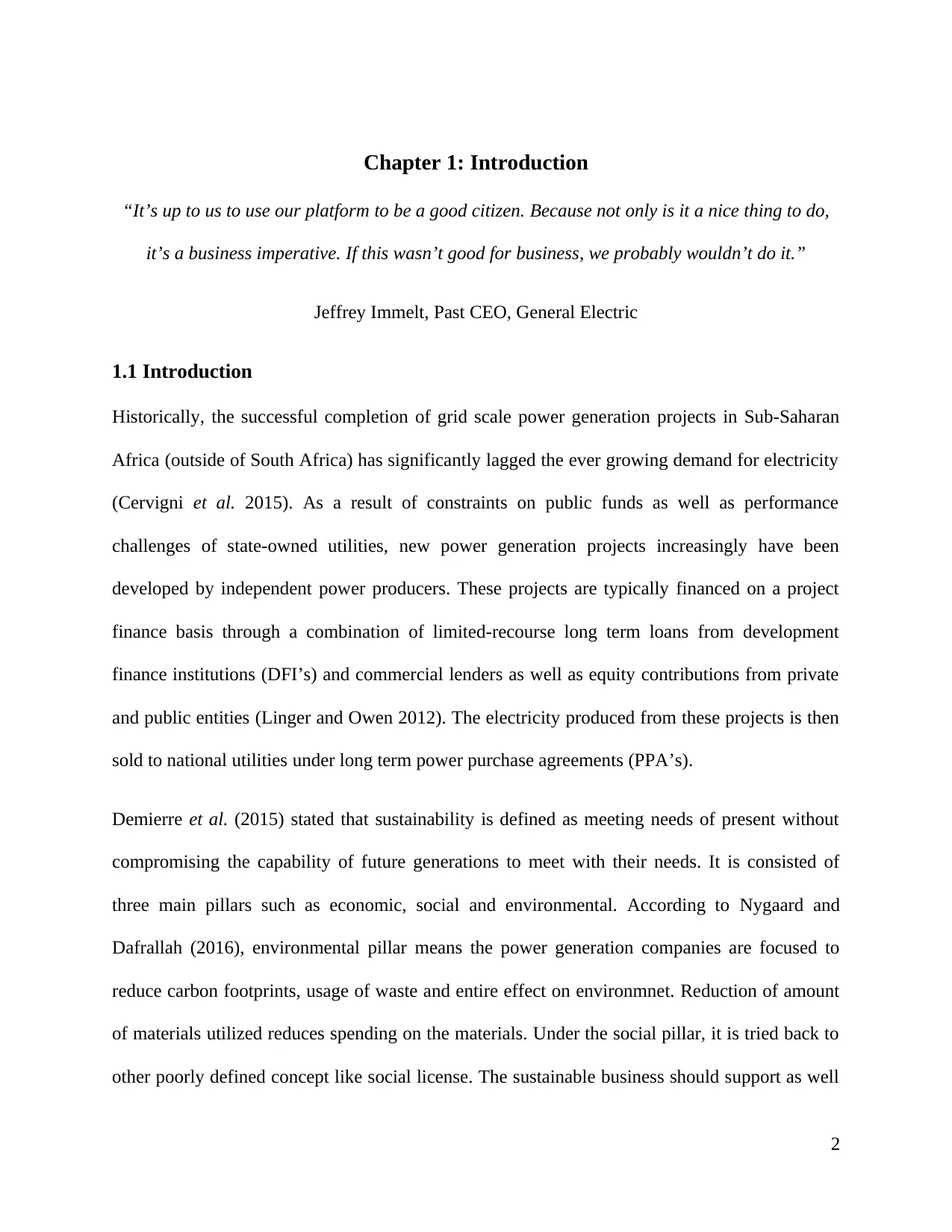
“It’s up to us to use our platform to be a good citizen. Because not only is it a nice thing to do,
it’s a business imperative. If this wasn’t good for business, we probably wouldn’t do it.”
Jeffrey Immelt, Past CEO, General Electric
1.1 Introduction
Historically, the successful completion of grid scale power generation projects in Sub-Saharan
Africa (outside of South Africa) has significantly lagged the ever growing demand for electricity
(Cervigni et al. 2015). As a result of constraints on public funds as well as performance
challenges of state-owned utilities, new power generation projects increasingly have been
developed by independent power producers. These projects are typically financed on a project
finance basis through a combination of limited-recourse long term loans from development
finance institutions (DFI’s) and commercial lenders as well as equity contributions from private
and public entities (Linger and Owen 2012). The electricity produced from these projects is then
sold to national utilities under long term power purchase agreements (PPA’s).
Demierre et al. (2015) stated that sustainability is defined as meeting needs of present without
compromising the capability of future generations to meet with their needs. It is consisted of
three main pillars such as economic, social and environmental. According to Nygaard and
Dafrallah (2016), environmental pillar means the power generation companies are focused to
reduce carbon footprints, usage of waste and entire effect on environmnet. Reduction of amount
of materials utilized reduces spending on the materials. Under the social pillar, it is tried back to
other poorly defined concept like social license. The sustainable business should support as well
2
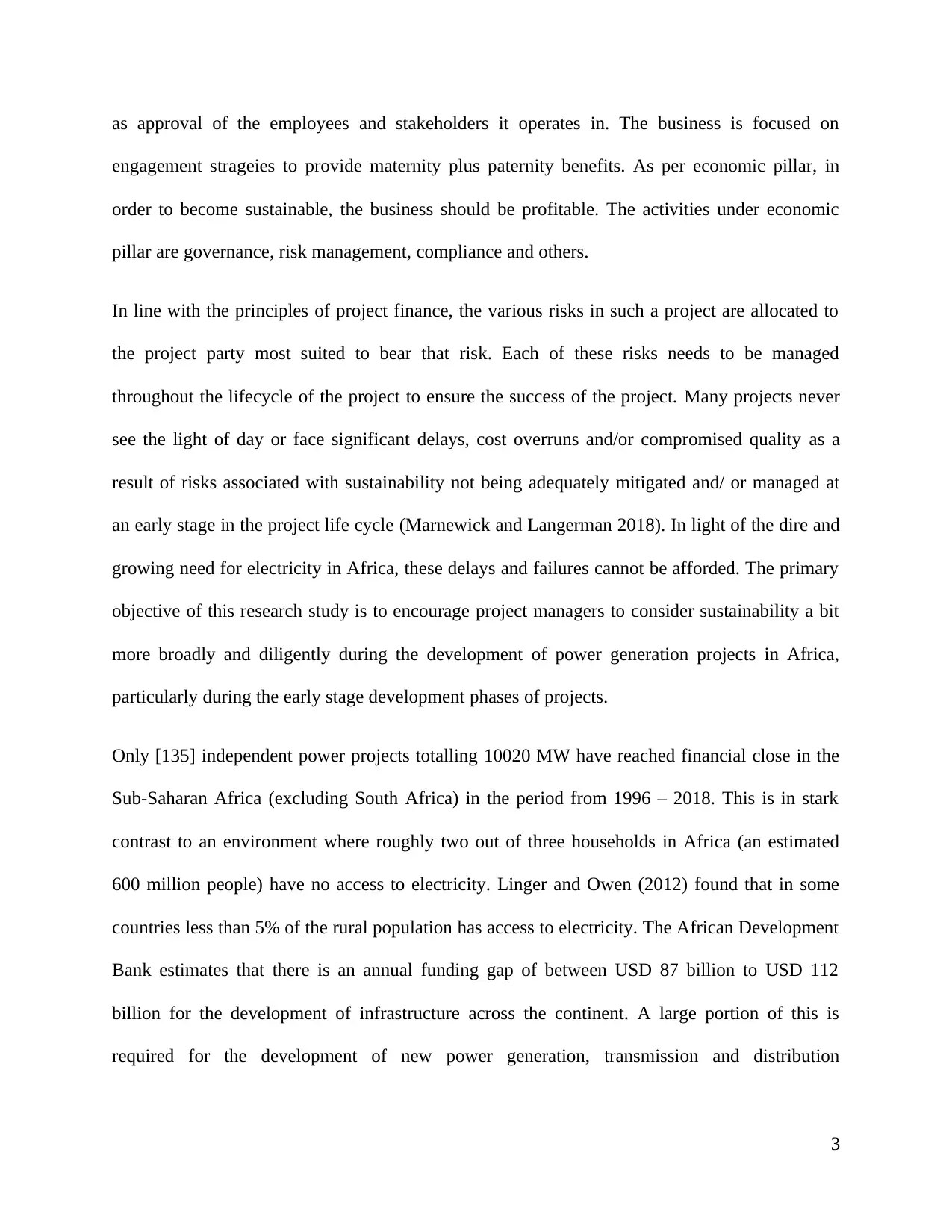
engagement strageies to provide maternity plus paternity benefits. As per economic pillar, in
order to become sustainable, the business should be profitable. The activities under economic
pillar are governance, risk management, compliance and others.
In line with the principles of project finance, the various risks in such a project are allocated to
the project party most suited to bear that risk. Each of these risks needs to be managed
throughout the lifecycle of the project to ensure the success of the project. Many projects never
see the light of day or face significant delays, cost overruns and/or compromised quality as a
result of risks associated with sustainability not being adequately mitigated and/ or managed at
an early stage in the project life cycle (Marnewick and Langerman 2018). In light of the dire and
growing need for electricity in Africa, these delays and failures cannot be afforded. The primary
objective of this research study is to encourage project managers to consider sustainability a bit
more broadly and diligently during the development of power generation projects in Africa,
particularly during the early stage development phases of projects.
Only [135] independent power projects totalling 10020 MW have reached financial close in the
Sub-Saharan Africa (excluding South Africa) in the period from 1996 – 2018. This is in stark
contrast to an environment where roughly two out of three households in Africa (an estimated
600 million people) have no access to electricity. Linger and Owen (2012) found that in some
countries less than 5% of the rural population has access to electricity. The African Development
Bank estimates that there is an annual funding gap of between USD 87 billion to USD 112
billion for the development of infrastructure across the continent. A large portion of this is
required for the development of new power generation, transmission and distribution
3
⊘ This is a preview!⊘
Do you want full access?
Subscribe today to unlock all pages.

Trusted by 1+ million students worldwide

generation capacity as a result of robust economic growth on the continent.
According to Marcelino-Sadaba, González-Jaenand Perez-Ezcurdiastated (2015), sustainable
energy provides accessible as well as reliable energy services that meet economic and
environmental requirements within the developmental context of a society. Africa’s renewable
energy power potential is larger than projected consumption of power of continent. The growth
of renewable based energy is desirable to three major sectors like electricity, heat plus transport.
Many projects are developed to minimum sustainability standards or legal compliance levels.
Marnewick and Langerman (2018) stated that if a different approach to standards could be taken,
issues causing delays, cost overruns and quality compromises could be avoided in future
projects. Some of the most widely used and comprehensive standards related to sustainability
reporting are those developed by the Global Reporting Initiative (GRI) .
ISO standards support three pillars of the sustainable development. In the economic pillar, ISO
international standards promote of economic sustainability by facilitating of the international
trade, improving over quality infrastructure and supporting the sustainable business practices. In
social pillar, the ISO standard promotes social sustainable by helping the communities in
improvement of citizens health. It is covered of social aspects related to products towards social
inclusion. Within environmental pillar, ISO standards promote of environmental sustainability by
helping the business to manage environmental impacts. Environmental management system
measures and reduces emissions of greenhouse gas (Visser and Tolhurst 2017). The sustainable
development goals achieve sustainable future for the power generation projects in South Africa.
It addresses challenges like poverty, environmental and climate.
4
Paraphrase This Document
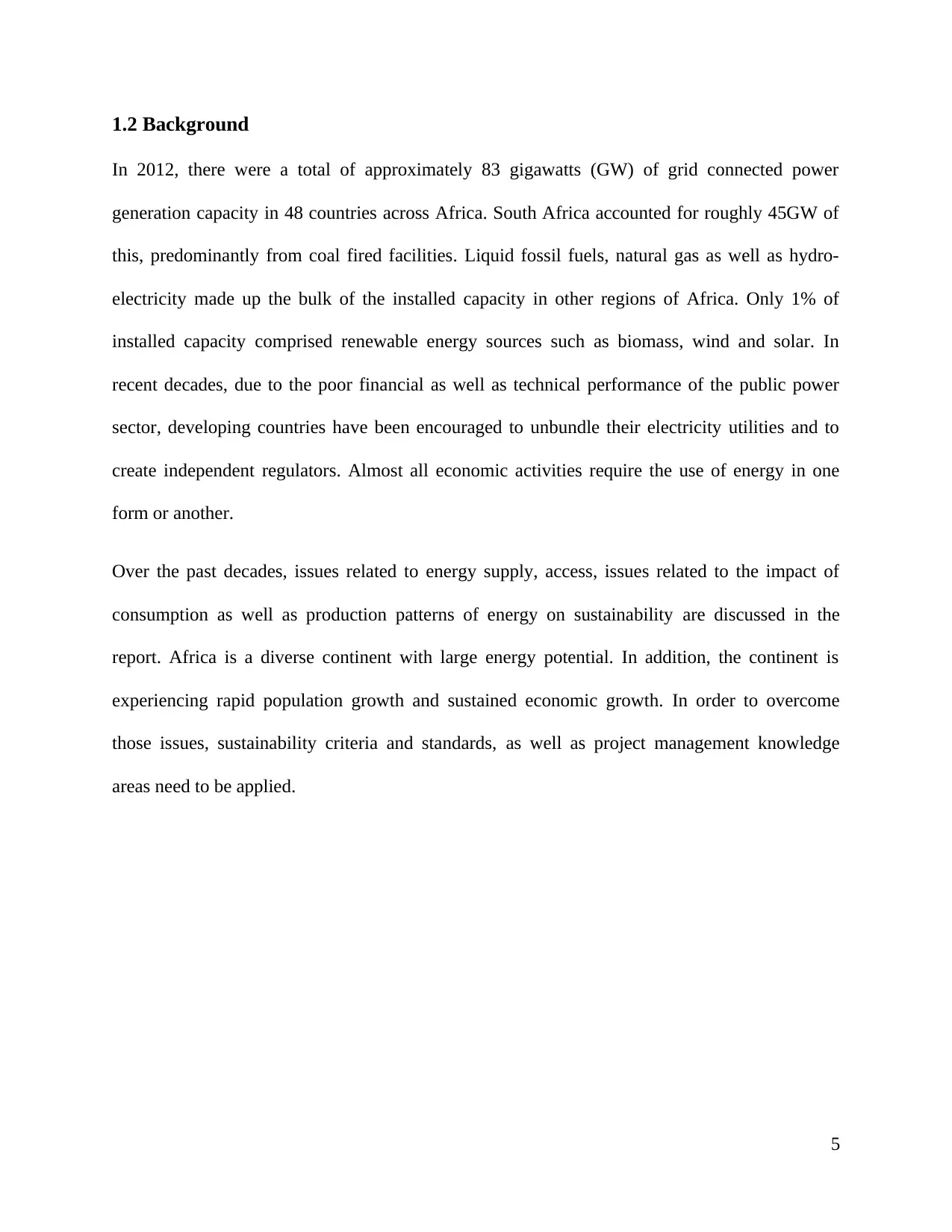
In 2012, there were a total of approximately 83 gigawatts (GW) of grid connected power
generation capacity in 48 countries across Africa. South Africa accounted for roughly 45GW of
this, predominantly from coal fired facilities. Liquid fossil fuels, natural gas as well as hydro-
electricity made up the bulk of the installed capacity in other regions of Africa. Only 1% of
installed capacity comprised renewable energy sources such as biomass, wind and solar. In
recent decades, due to the poor financial as well as technical performance of the public power
sector, developing countries have been encouraged to unbundle their electricity utilities and to
create independent regulators. Almost all economic activities require the use of energy in one
form or another.
Over the past decades, issues related to energy supply, access, issues related to the impact of
consumption as well as production patterns of energy on sustainability are discussed in the
report. Africa is a diverse continent with large energy potential. In addition, the continent is
experiencing rapid population growth and sustained economic growth. In order to overcome
those issues, sustainability criteria and standards, as well as project management knowledge
areas need to be applied.
5

(Source: Calvin et al. 2016, pp-112)
Figure 2: Electricity consumption in all over the world
(Source: Saidi and Hammami 2015, pp-65)
6
⊘ This is a preview!⊘
Do you want full access?
Subscribe today to unlock all pages.

Trusted by 1+ million students worldwide
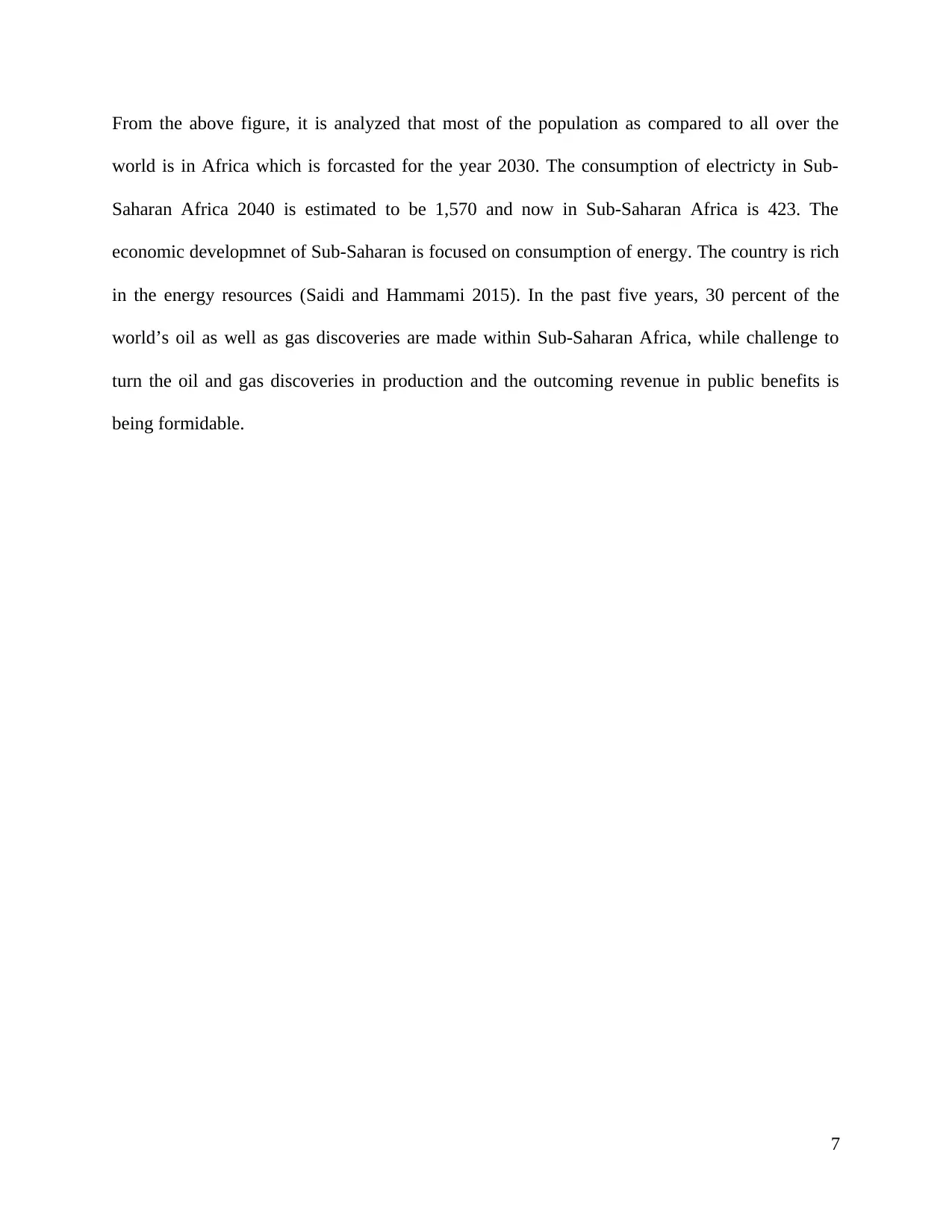
world is in Africa which is forcasted for the year 2030. The consumption of electricty in Sub-
Saharan Africa 2040 is estimated to be 1,570 and now in Sub-Saharan Africa is 423. The
economic developmnet of Sub-Saharan is focused on consumption of energy. The country is rich
in the energy resources (Saidi and Hammami 2015). In the past five years, 30 percent of the
world’s oil as well as gas discoveries are made within Sub-Saharan Africa, while challenge to
turn the oil and gas discoveries in production and the outcoming revenue in public benefits is
being formidable.
7
Paraphrase This Document
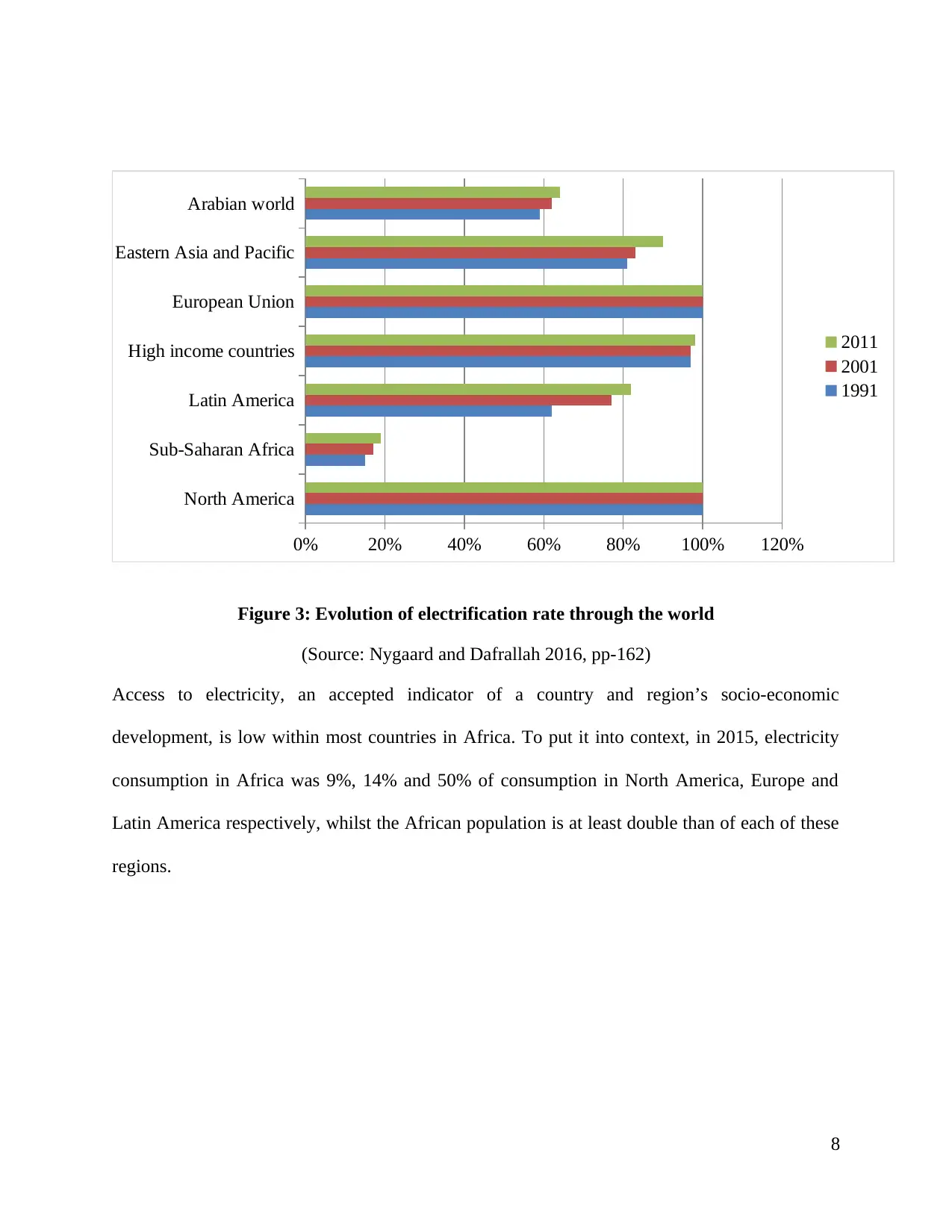
(Source: Nygaard and Dafrallah 2016, pp-162)
Access to electricity, an accepted indicator of a country and region’s socio-economic
development, is low within most countries in Africa. To put it into context, in 2015, electricity
consumption in Africa was 9%, 14% and 50% of consumption in North America, Europe and
Latin America respectively, whilst the African population is at least double than of each of these
regions.
8
North America
Sub-Saharan Africa
Latin America
High income countries
European Union
Eastern Asia and Pacific
Arabian world
0% 20% 40% 60% 80% 100% 120%
2011
2001
1991
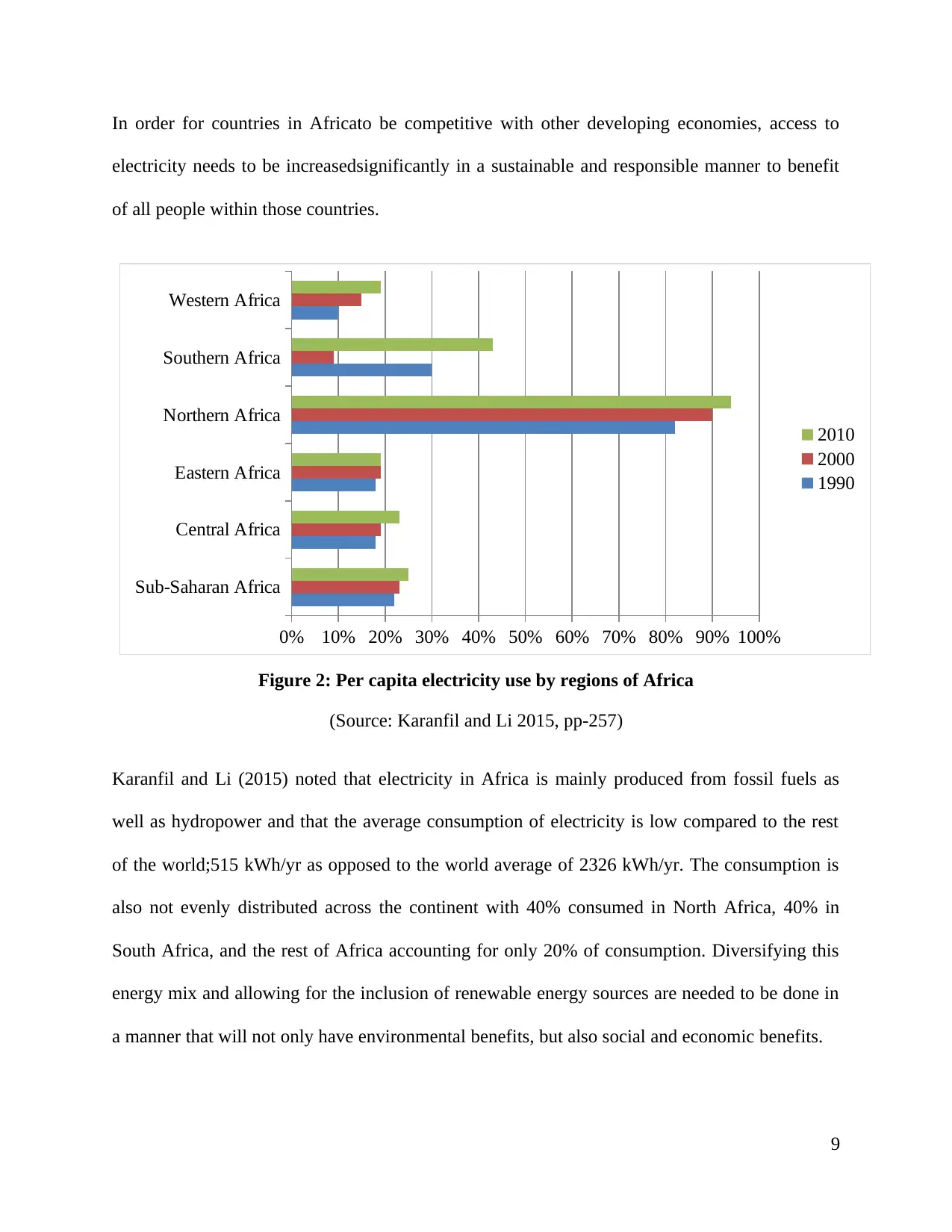
electricity needs to be increasedsignificantly in a sustainable and responsible manner to benefit
of all people within those countries.
Figure 2: Per capita electricity use by regions of Africa
(Source: Karanfil and Li 2015, pp-257)
Karanfil and Li (2015) noted that electricity in Africa is mainly produced from fossil fuels as
well as hydropower and that the average consumption of electricity is low compared to the rest
of the world;515 kWh/yr as opposed to the world average of 2326 kWh/yr. The consumption is
also not evenly distributed across the continent with 40% consumed in North Africa, 40% in
South Africa, and the rest of Africa accounting for only 20% of consumption. Diversifying this
energy mix and allowing for the inclusion of renewable energy sources are needed to be done in
a manner that will not only have environmental benefits, but also social and economic benefits.
9
Sub-Saharan Africa
Central Africa
Eastern Africa
Northern Africa
Southern Africa
Western Africa
0% 10% 20% 30% 40% 50% 60% 70% 80% 90% 100%
2010
2000
1990
⊘ This is a preview!⊘
Do you want full access?
Subscribe today to unlock all pages.

Trusted by 1+ million students worldwide
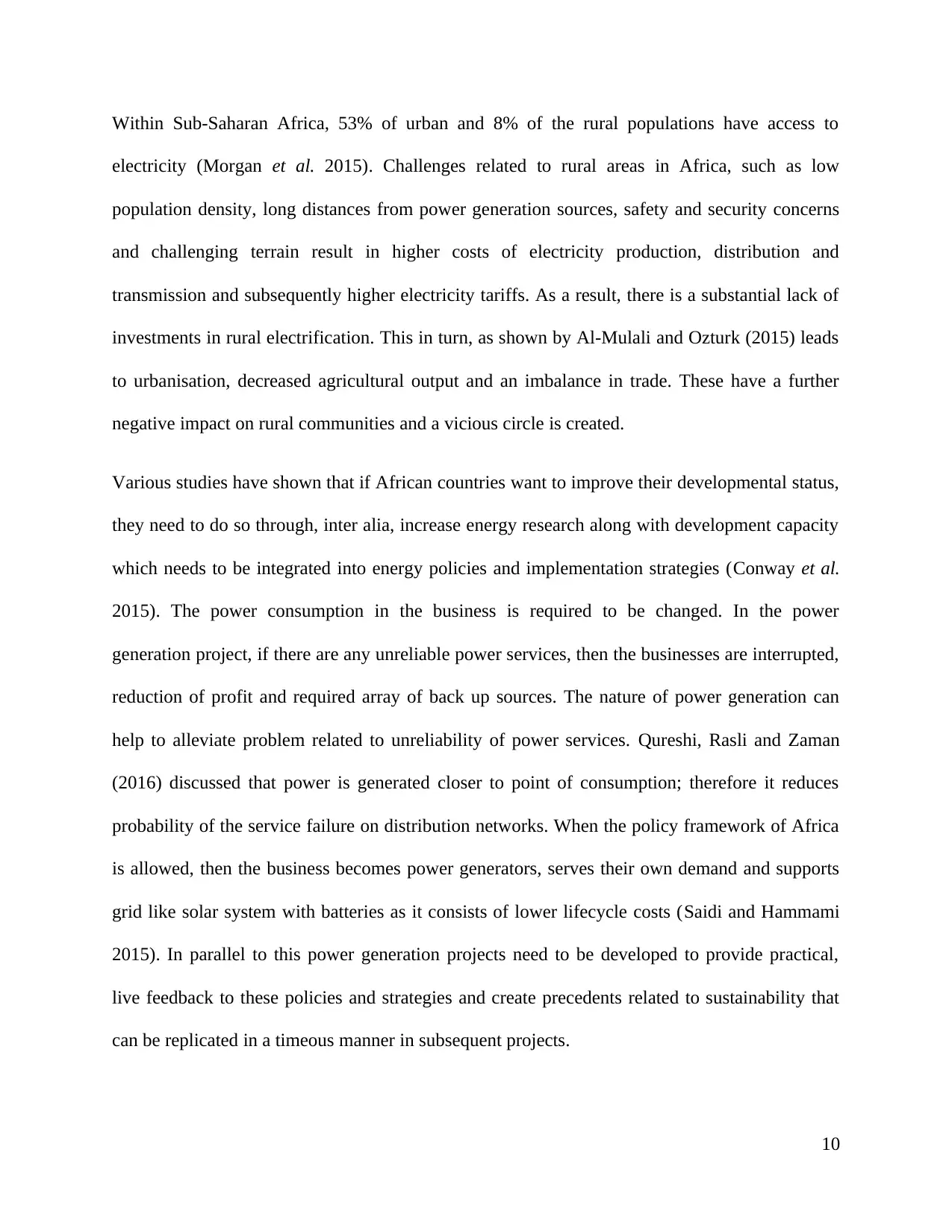
electricity (Morgan et al. 2015). Challenges related to rural areas in Africa, such as low
population density, long distances from power generation sources, safety and security concerns
and challenging terrain result in higher costs of electricity production, distribution and
transmission and subsequently higher electricity tariffs. As a result, there is a substantial lack of
investments in rural electrification. This in turn, as shown by Al-Mulali and Ozturk (2015) leads
to urbanisation, decreased agricultural output and an imbalance in trade. These have a further
negative impact on rural communities and a vicious circle is created.
Various studies have shown that if African countries want to improve their developmental status,
they need to do so through, inter alia, increase energy research along with development capacity
which needs to be integrated into energy policies and implementation strategies (Conway et al.
2015). The power consumption in the business is required to be changed. In the power
generation project, if there are any unreliable power services, then the businesses are interrupted,
reduction of profit and required array of back up sources. The nature of power generation can
help to alleviate problem related to unreliability of power services. Qureshi, Rasli and Zaman
(2016) discussed that power is generated closer to point of consumption; therefore it reduces
probability of the service failure on distribution networks. When the policy framework of Africa
is allowed, then the business becomes power generators, serves their own demand and supports
grid like solar system with batteries as it consists of lower lifecycle costs (Saidi and Hammami
2015). In parallel to this power generation projects need to be developed to provide practical,
live feedback to these policies and strategies and create precedents related to sustainability that
can be replicated in a timeous manner in subsequent projects.
10
Paraphrase This Document
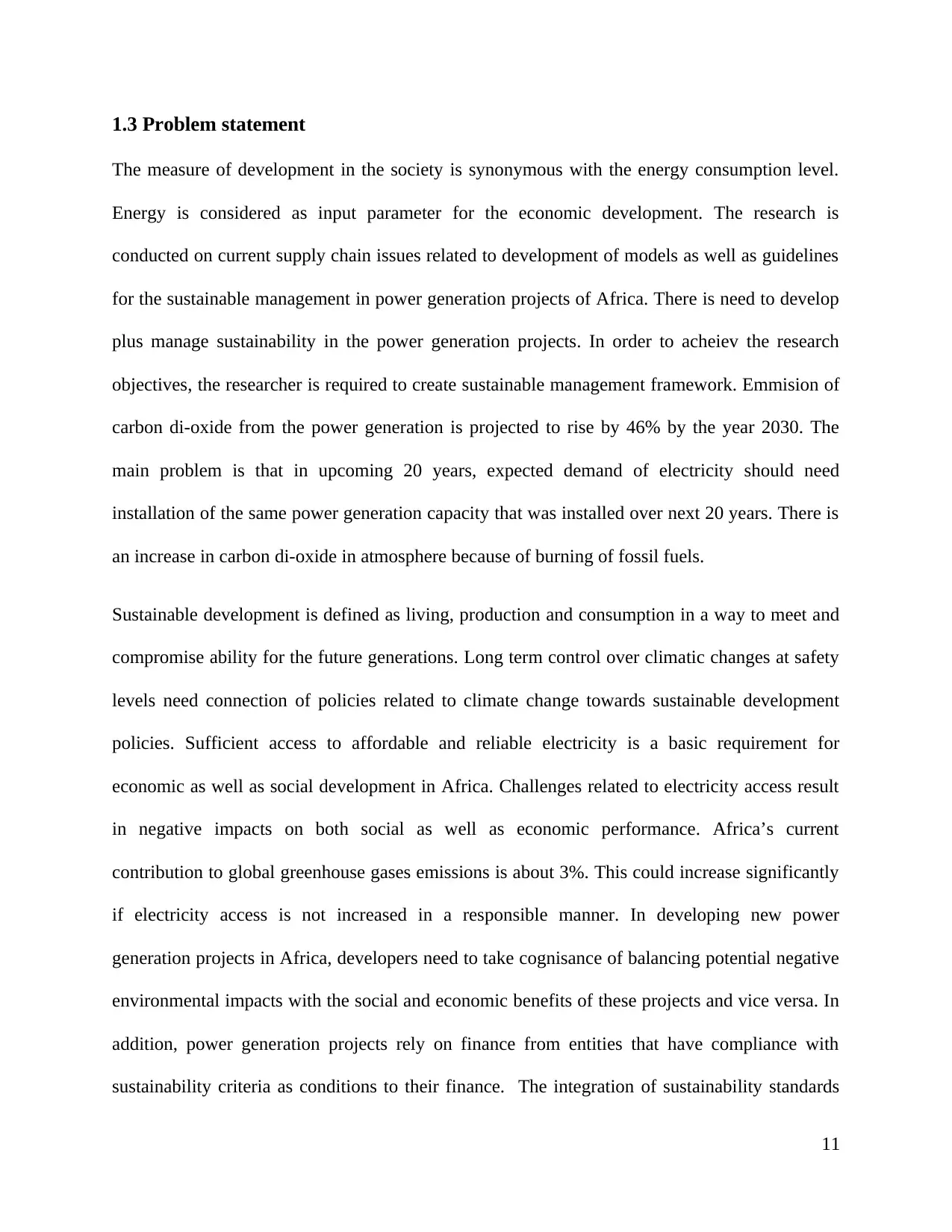
The measure of development in the society is synonymous with the energy consumption level.
Energy is considered as input parameter for the economic development. The research is
conducted on current supply chain issues related to development of models as well as guidelines
for the sustainable management in power generation projects of Africa. There is need to develop
plus manage sustainability in the power generation projects. In order to acheiev the research
objectives, the researcher is required to create sustainable management framework. Emmision of
carbon di-oxide from the power generation is projected to rise by 46% by the year 2030. The
main problem is that in upcoming 20 years, expected demand of electricity should need
installation of the same power generation capacity that was installed over next 20 years. There is
an increase in carbon di-oxide in atmosphere because of burning of fossil fuels.
Sustainable development is defined as living, production and consumption in a way to meet and
compromise ability for the future generations. Long term control over climatic changes at safety
levels need connection of policies related to climate change towards sustainable development
policies. Sufficient access to affordable and reliable electricity is a basic requirement for
economic as well as social development in Africa. Challenges related to electricity access result
in negative impacts on both social as well as economic performance. Africa’s current
contribution to global greenhouse gases emissions is about 3%. This could increase significantly
if electricity access is not increased in a responsible manner. In developing new power
generation projects in Africa, developers need to take cognisance of balancing potential negative
environmental impacts with the social and economic benefits of these projects and vice versa. In
addition, power generation projects rely on finance from entities that have compliance with
sustainability criteria as conditions to their finance. The integration of sustainability standards
11
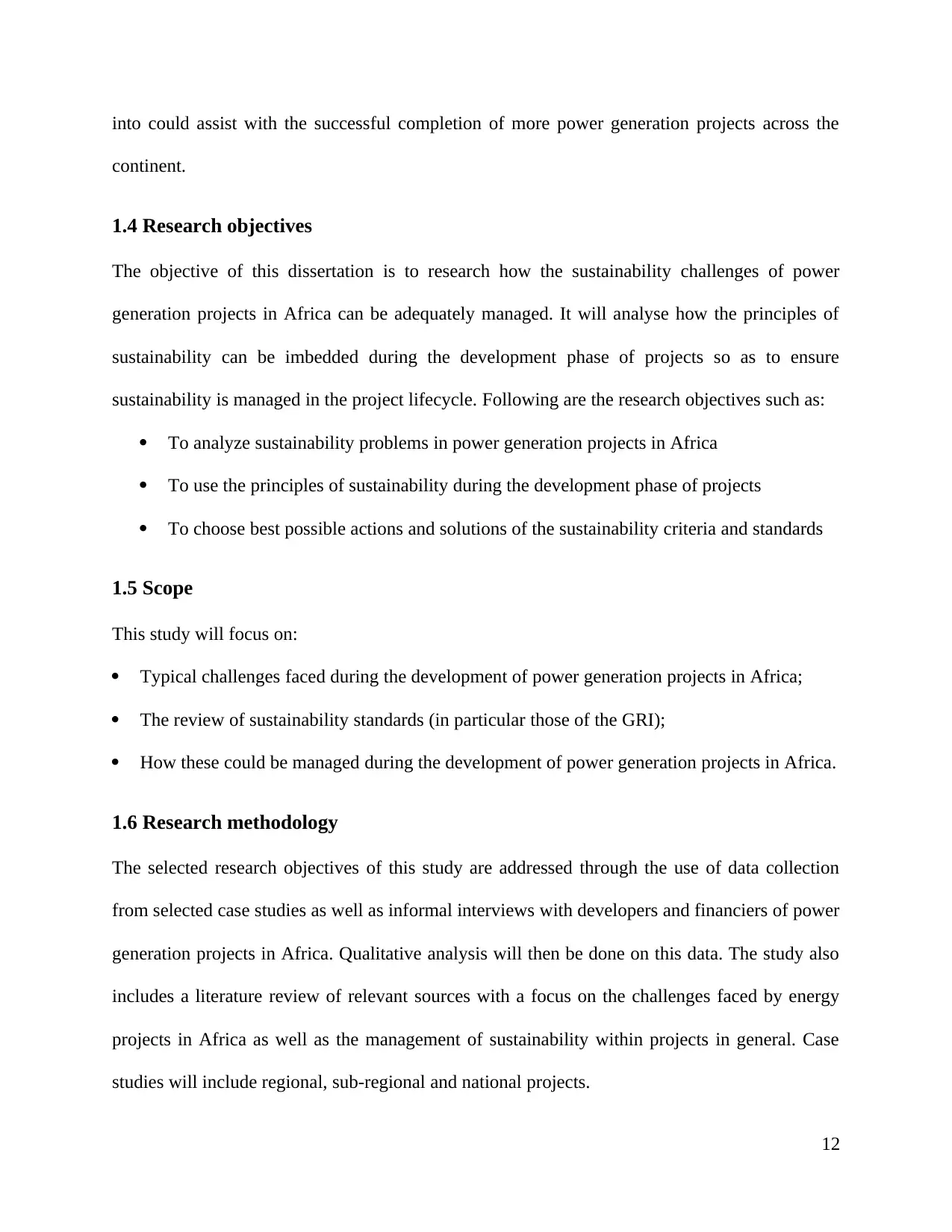
continent.
1.4 Research objectives
The objective of this dissertation is to research how the sustainability challenges of power
generation projects in Africa can be adequately managed. It will analyse how the principles of
sustainability can be imbedded during the development phase of projects so as to ensure
sustainability is managed in the project lifecycle. Following are the research objectives such as:
To analyze sustainability problems in power generation projects in Africa
To use the principles of sustainability during the development phase of projects
To choose best possible actions and solutions of the sustainability criteria and standards
1.5 Scope
This study will focus on:
Typical challenges faced during the development of power generation projects in Africa;
The review of sustainability standards (in particular those of the GRI);
How these could be managed during the development of power generation projects in Africa.
1.6 Research methodology
The selected research objectives of this study are addressed through the use of data collection
from selected case studies as well as informal interviews with developers and financiers of power
generation projects in Africa. Qualitative analysis will then be done on this data. The study also
includes a literature review of relevant sources with a focus on the challenges faced by energy
projects in Africa as well as the management of sustainability within projects in general. Case
studies will include regional, sub-regional and national projects.
12
⊘ This is a preview!⊘
Do you want full access?
Subscribe today to unlock all pages.

Trusted by 1+ million students worldwide
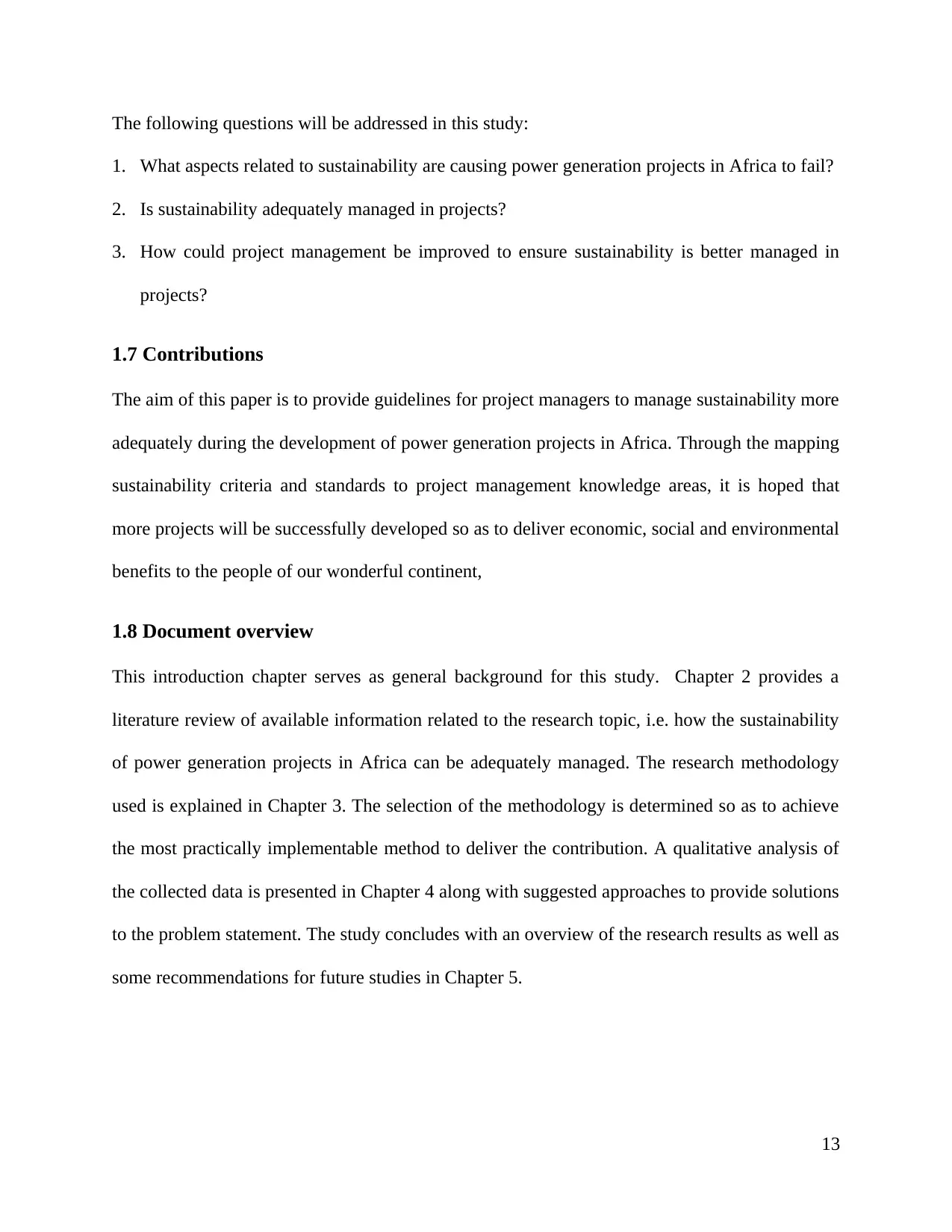
1. What aspects related to sustainability are causing power generation projects in Africa to fail?
2. Is sustainability adequately managed in projects?
3. How could project management be improved to ensure sustainability is better managed in
projects?
1.7 Contributions
The aim of this paper is to provide guidelines for project managers to manage sustainability more
adequately during the development of power generation projects in Africa. Through the mapping
sustainability criteria and standards to project management knowledge areas, it is hoped that
more projects will be successfully developed so as to deliver economic, social and environmental
benefits to the people of our wonderful continent,
1.8 Document overview
This introduction chapter serves as general background for this study. Chapter 2 provides a
literature review of available information related to the research topic, i.e. how the sustainability
of power generation projects in Africa can be adequately managed. The research methodology
used is explained in Chapter 3. The selection of the methodology is determined so as to achieve
the most practically implementable method to deliver the contribution. A qualitative analysis of
the collected data is presented in Chapter 4 along with suggested approaches to provide solutions
to the problem statement. The study concludes with an overview of the research results as well as
some recommendations for future studies in Chapter 5.
13
Paraphrase This Document
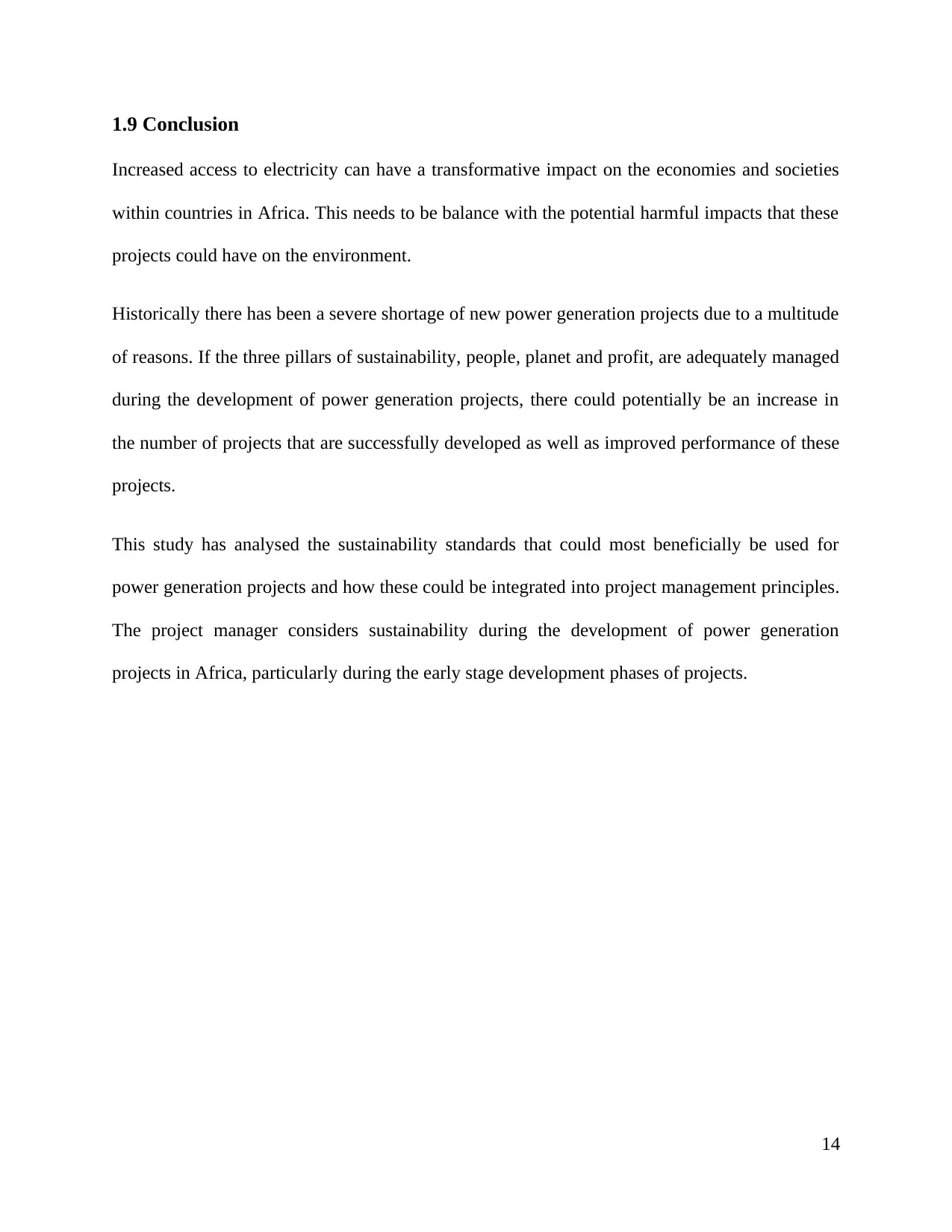
Increased access to electricity can have a transformative impact on the economies and societies
within countries in Africa. This needs to be balance with the potential harmful impacts that these
projects could have on the environment.
Historically there has been a severe shortage of new power generation projects due to a multitude
of reasons. If the three pillars of sustainability, people, planet and profit, are adequately managed
during the development of power generation projects, there could potentially be an increase in
the number of projects that are successfully developed as well as improved performance of these
projects.
This study has analysed the sustainability standards that could most beneficially be used for
power generation projects and how these could be integrated into project management principles.
The project manager considers sustainability during the development of power generation
projects in Africa, particularly during the early stage development phases of projects.
14
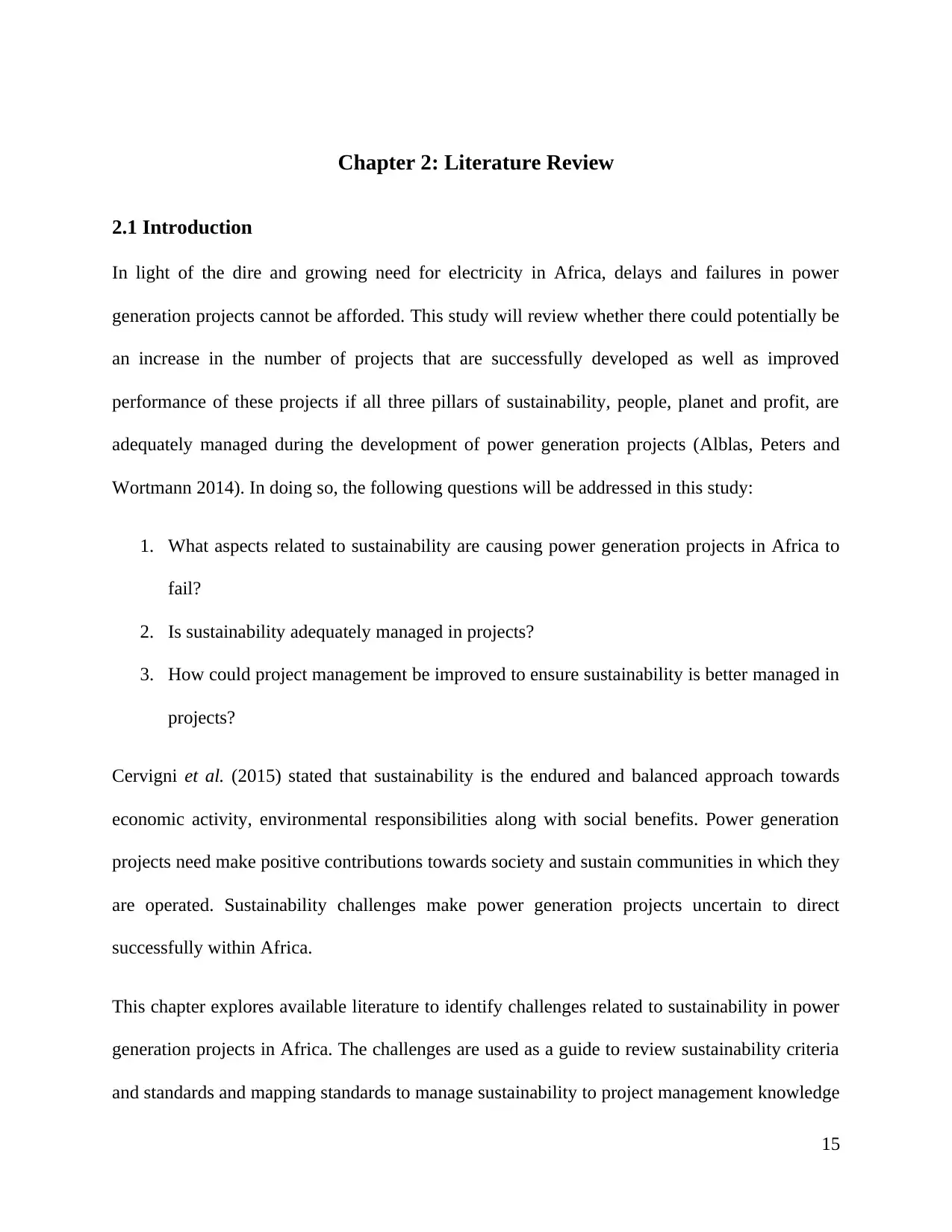
2.1 Introduction
In light of the dire and growing need for electricity in Africa, delays and failures in power
generation projects cannot be afforded. This study will review whether there could potentially be
an increase in the number of projects that are successfully developed as well as improved
performance of these projects if all three pillars of sustainability, people, planet and profit, are
adequately managed during the development of power generation projects (Alblas, Peters and
Wortmann 2014). In doing so, the following questions will be addressed in this study:
1. What aspects related to sustainability are causing power generation projects in Africa to
fail?
2. Is sustainability adequately managed in projects?
3. How could project management be improved to ensure sustainability is better managed in
projects?
Cervigni et al. (2015) stated that sustainability is the endured and balanced approach towards
economic activity, environmental responsibilities along with social benefits. Power generation
projects need make positive contributions towards society and sustain communities in which they
are operated. Sustainability challenges make power generation projects uncertain to direct
successfully within Africa.
This chapter explores available literature to identify challenges related to sustainability in power
generation projects in Africa. The challenges are used as a guide to review sustainability criteria
and standards and mapping standards to manage sustainability to project management knowledge
15
⊘ This is a preview!⊘
Do you want full access?
Subscribe today to unlock all pages.

Trusted by 1+ million students worldwide

development of power generation projects in Africa.
2.2 Sustainable energy systems
The bulk of Africa’s power generation system is powered by fossil fuels. Other sources of
generation include nuclear hydro, pumped storage as well as biomass. Due to the large installed
capacity in South Africa, coal is by far the largest source of fuel for power generation on the
continent (De Villiers, Rouse and Kerr 2016). Figure 2.1 below shows that South Africa’s
emissions intensity per capita is higher than a number of developing nations such as China and
India where there is greater coal use and higher than Brazil with its challenges related to
deforestation.
Figure 2.1: Emissions per capita
(Source: Borges et al. 2015, pp- 637)
16
South
Africa Brazil China India OECD World
0
5
10
15
20
Emissions per capita
Deforestion
t CO2 eq per person
Paraphrase This Document
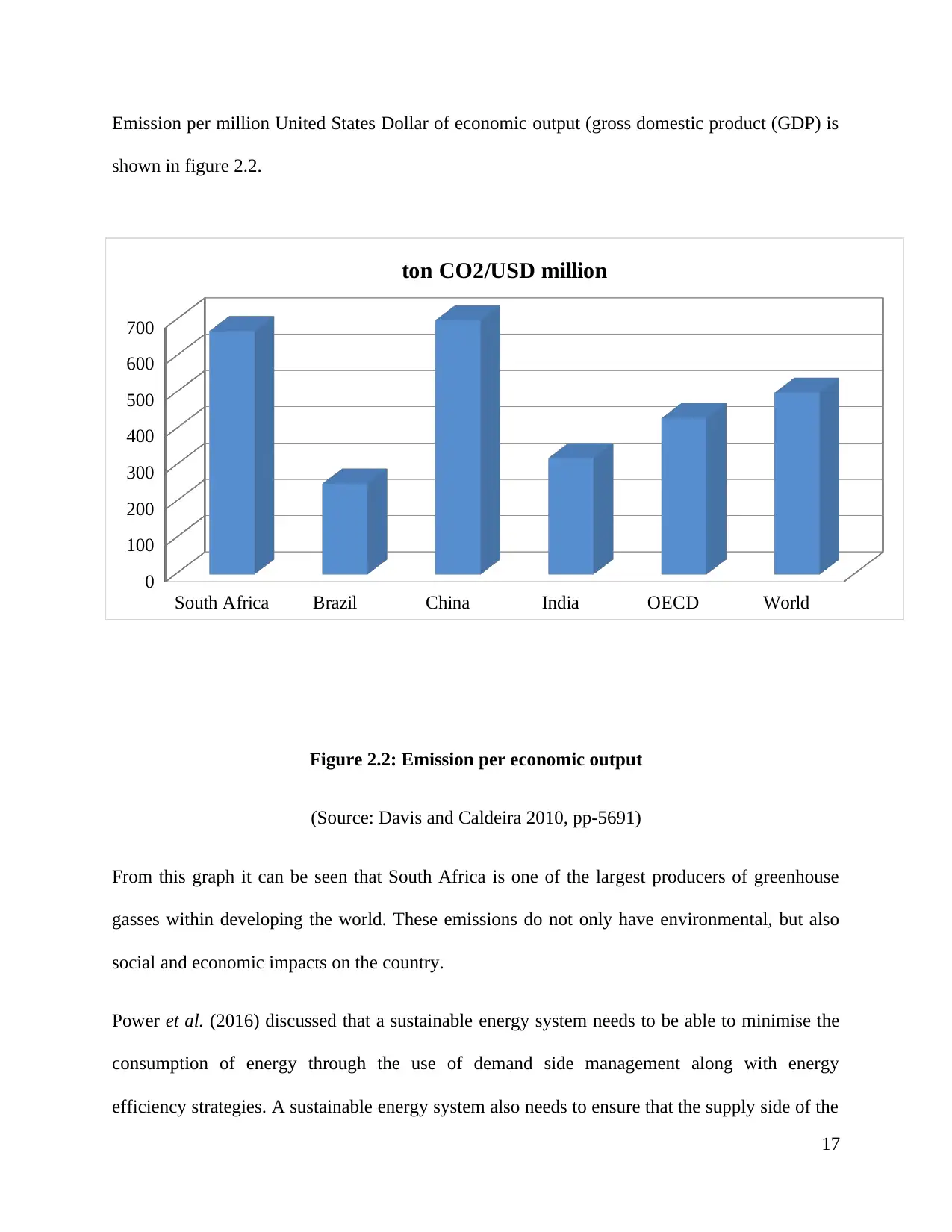
shown in figure 2.2.
Figure 2.2: Emission per economic output
(Source: Davis and Caldeira 2010, pp-5691)
From this graph it can be seen that South Africa is one of the largest producers of greenhouse
gasses within developing the world. These emissions do not only have environmental, but also
social and economic impacts on the country.
Power et al. (2016) discussed that a sustainable energy system needs to be able to minimise the
consumption of energy through the use of demand side management along with energy
efficiency strategies. A sustainable energy system also needs to ensure that the supply side of the
17
South Africa Brazil China India OECD World
0
100
200
300
400
500
600
700
ton CO2/USD million
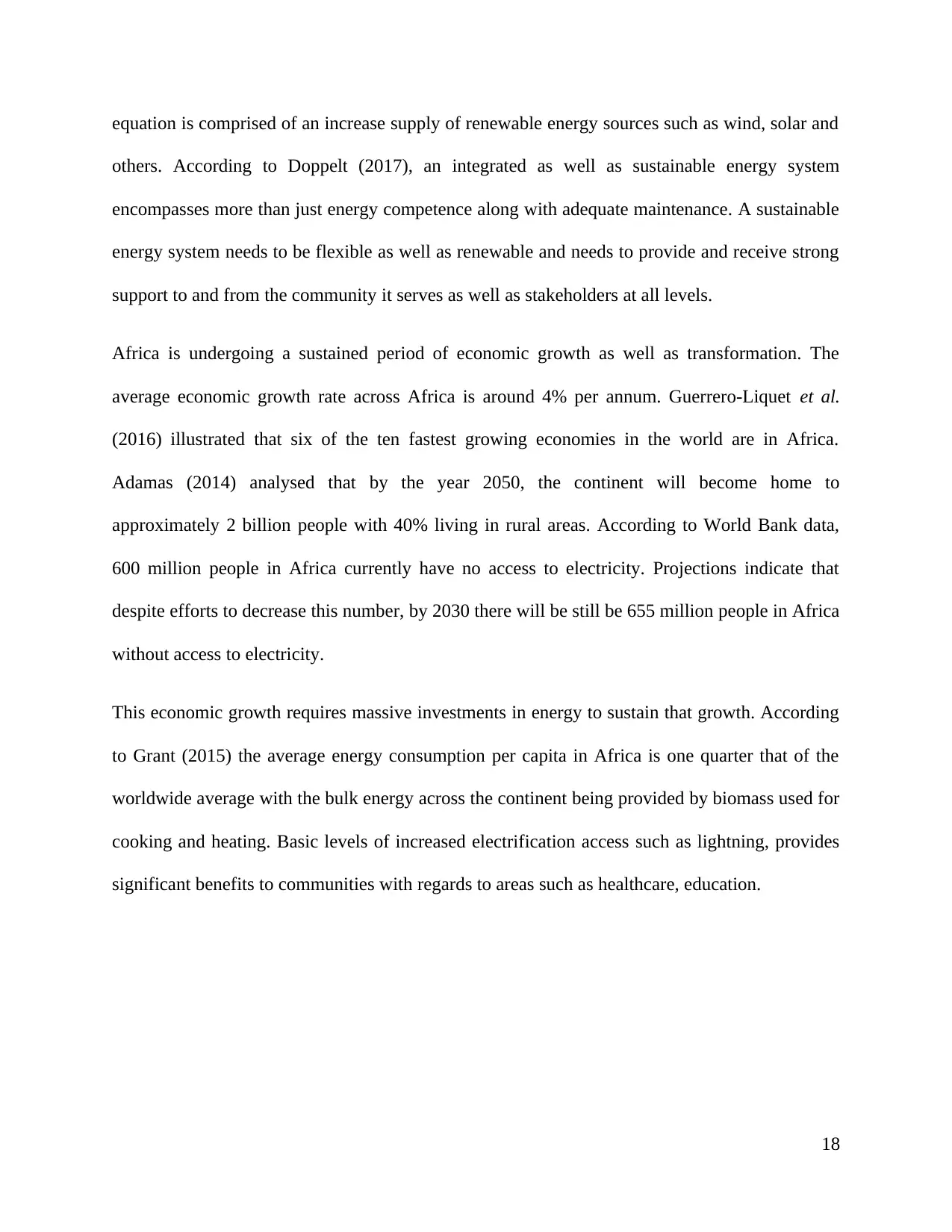
others. According to Doppelt (2017), an integrated as well as sustainable energy system
encompasses more than just energy competence along with adequate maintenance. A sustainable
energy system needs to be flexible as well as renewable and needs to provide and receive strong
support to and from the community it serves as well as stakeholders at all levels.
Africa is undergoing a sustained period of economic growth as well as transformation. The
average economic growth rate across Africa is around 4% per annum. Guerrero-Liquet et al.
(2016) illustrated that six of the ten fastest growing economies in the world are in Africa.
Adamas (2014) analysed that by the year 2050, the continent will become home to
approximately 2 billion people with 40% living in rural areas. According to World Bank data,
600 million people in Africa currently have no access to electricity. Projections indicate that
despite efforts to decrease this number, by 2030 there will be still be 655 million people in Africa
without access to electricity.
This economic growth requires massive investments in energy to sustain that growth. According
to Grant (2015) the average energy consumption per capita in Africa is one quarter that of the
worldwide average with the bulk energy across the continent being provided by biomass used for
cooking and heating. Basic levels of increased electrification access such as lightning, provides
significant benefits to communities with regards to areas such as healthcare, education.
18
⊘ This is a preview!⊘
Do you want full access?
Subscribe today to unlock all pages.

Trusted by 1+ million students worldwide
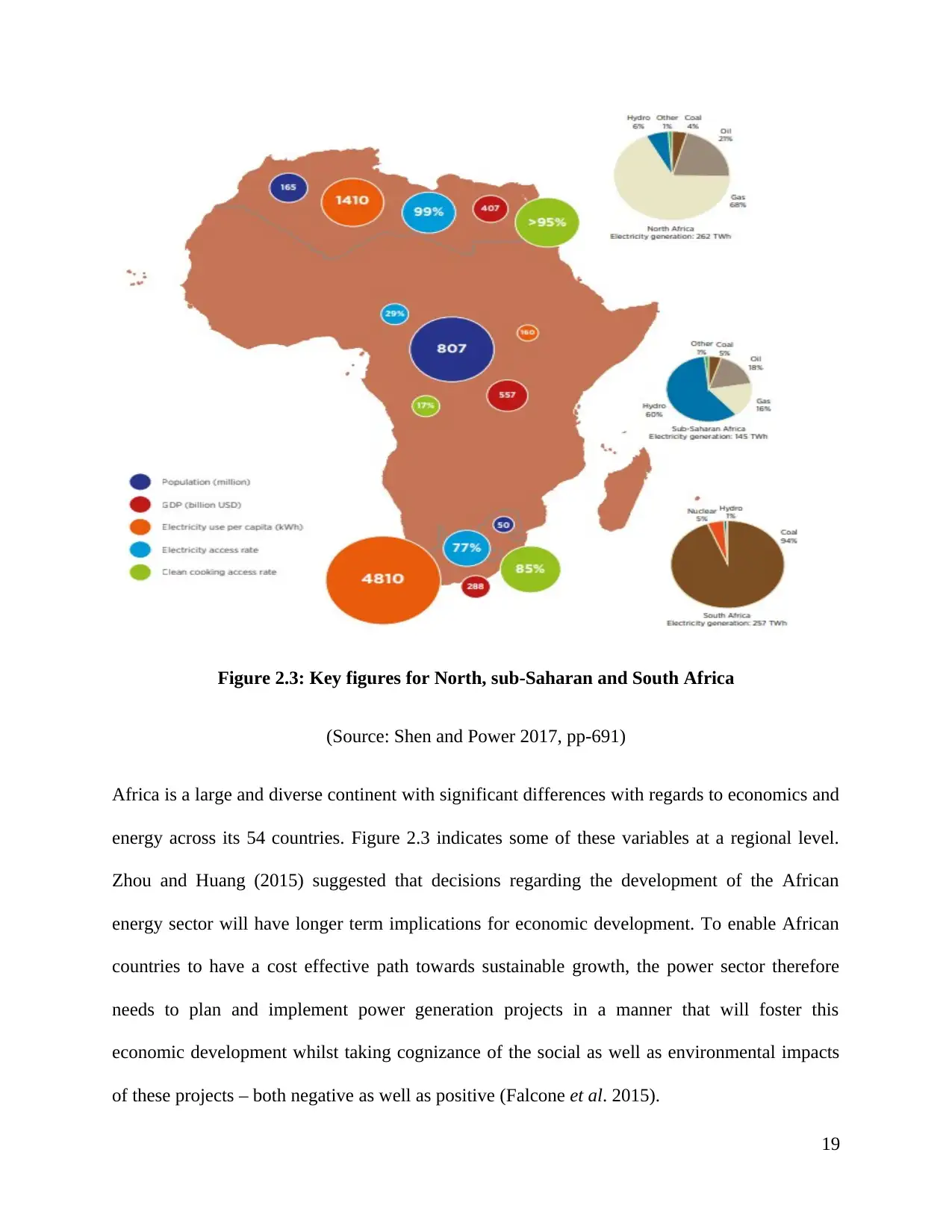
(Source: Shen and Power 2017, pp-691)
Africa is a large and diverse continent with significant differences with regards to economics and
energy across its 54 countries. Figure 2.3 indicates some of these variables at a regional level.
Zhou and Huang (2015) suggested that decisions regarding the development of the African
energy sector will have longer term implications for economic development. To enable African
countries to have a cost effective path towards sustainable growth, the power sector therefore
needs to plan and implement power generation projects in a manner that will foster this
economic development whilst taking cognizance of the social as well as environmental impacts
of these projects – both negative as well as positive (Falcone et al. 2015).
19
Paraphrase This Document
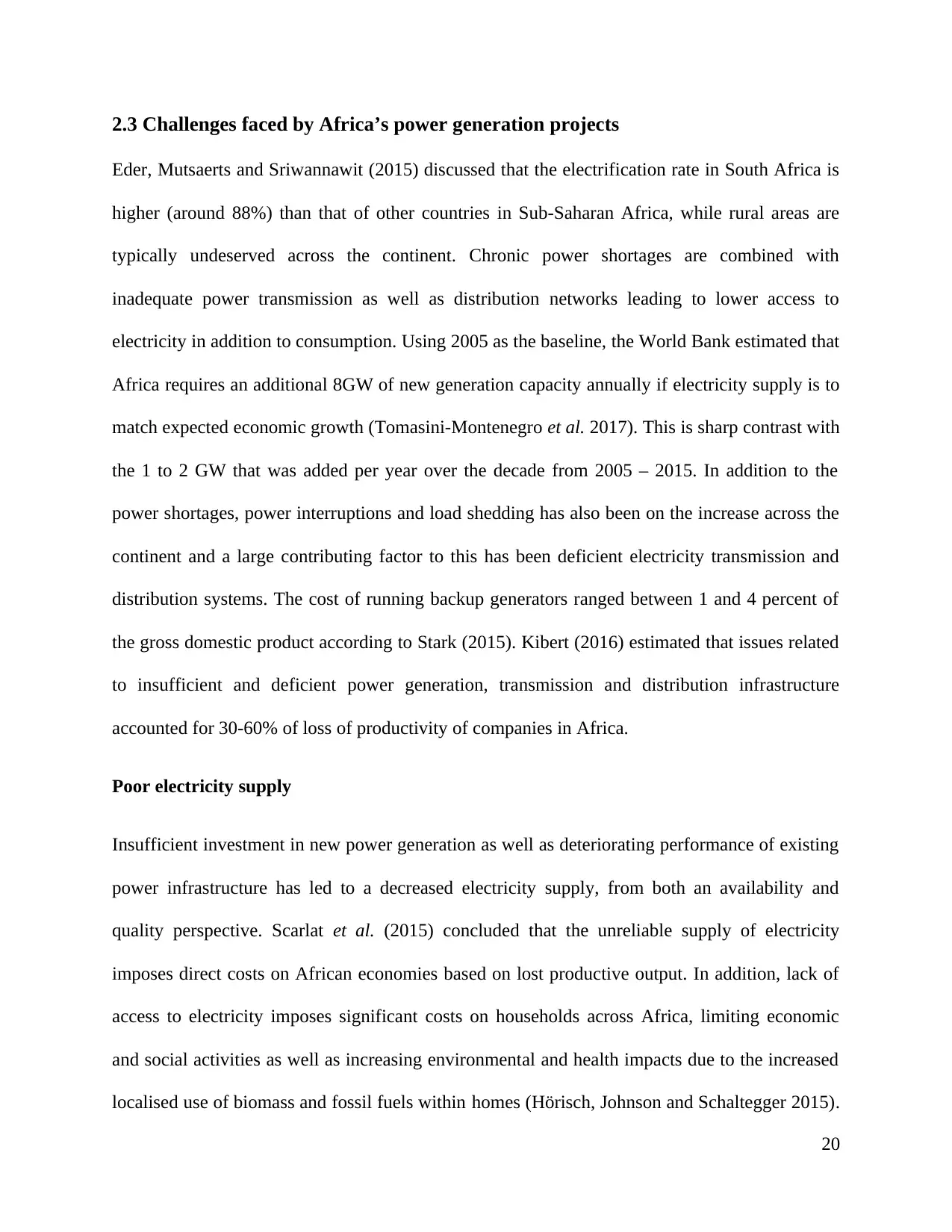
Eder, Mutsaerts and Sriwannawit (2015) discussed that the electrification rate in South Africa is
higher (around 88%) than that of other countries in Sub-Saharan Africa, while rural areas are
typically undeserved across the continent. Chronic power shortages are combined with
inadequate power transmission as well as distribution networks leading to lower access to
electricity in addition to consumption. Using 2005 as the baseline, the World Bank estimated that
Africa requires an additional 8GW of new generation capacity annually if electricity supply is to
match expected economic growth (Tomasini-Montenegro et al. 2017). This is sharp contrast with
the 1 to 2 GW that was added per year over the decade from 2005 – 2015. In addition to the
power shortages, power interruptions and load shedding has also been on the increase across the
continent and a large contributing factor to this has been deficient electricity transmission and
distribution systems. The cost of running backup generators ranged between 1 and 4 percent of
the gross domestic product according to Stark (2015). Kibert (2016) estimated that issues related
to insufficient and deficient power generation, transmission and distribution infrastructure
accounted for 30-60% of loss of productivity of companies in Africa.
Poor electricity supply
Insufficient investment in new power generation as well as deteriorating performance of existing
power infrastructure has led to a decreased electricity supply, from both an availability and
quality perspective. Scarlat et al. (2015) concluded that the unreliable supply of electricity
imposes direct costs on African economies based on lost productive output. In addition, lack of
access to electricity imposes significant costs on households across Africa, limiting economic
and social activities as well as increasing environmental and health impacts due to the increased
localised use of biomass and fossil fuels within homes (Hörisch, Johnson and Schaltegger 2015).
20
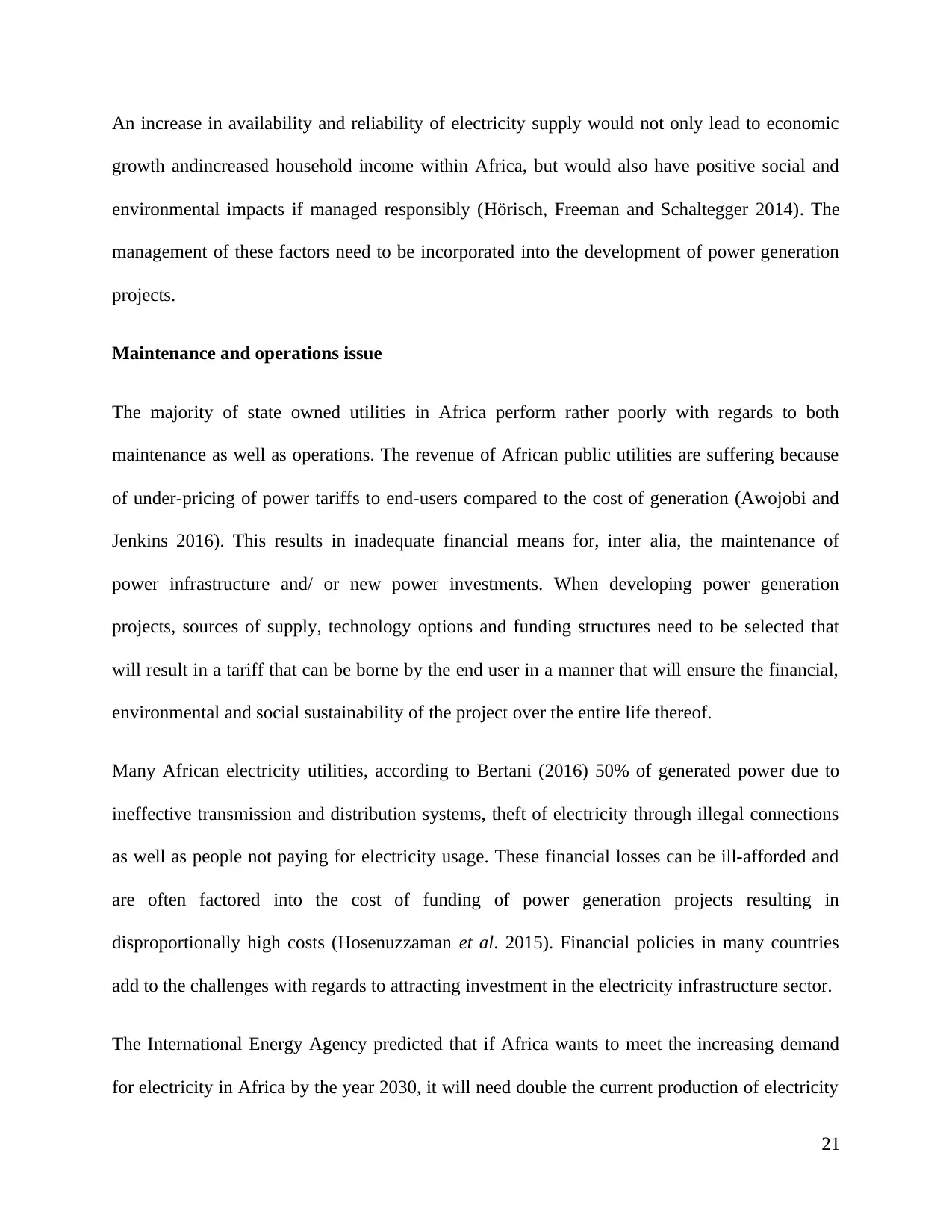
growth andincreased household income within Africa, but would also have positive social and
environmental impacts if managed responsibly (Hörisch, Freeman and Schaltegger 2014). The
management of these factors need to be incorporated into the development of power generation
projects.
Maintenance and operations issue
The majority of state owned utilities in Africa perform rather poorly with regards to both
maintenance as well as operations. The revenue of African public utilities are suffering because
of under-pricing of power tariffs to end-users compared to the cost of generation (Awojobi and
Jenkins 2016). This results in inadequate financial means for, inter alia, the maintenance of
power infrastructure and/ or new power investments. When developing power generation
projects, sources of supply, technology options and funding structures need to be selected that
will result in a tariff that can be borne by the end user in a manner that will ensure the financial,
environmental and social sustainability of the project over the entire life thereof.
Many African electricity utilities, according to Bertani (2016) 50% of generated power due to
ineffective transmission and distribution systems, theft of electricity through illegal connections
as well as people not paying for electricity usage. These financial losses can be ill-afforded and
are often factored into the cost of funding of power generation projects resulting in
disproportionally high costs (Hosenuzzaman et al. 2015). Financial policies in many countries
add to the challenges with regards to attracting investment in the electricity infrastructure sector.
The International Energy Agency predicted that if Africa wants to meet the increasing demand
for electricity in Africa by the year 2030, it will need double the current production of electricity
21
⊘ This is a preview!⊘
Do you want full access?
Subscribe today to unlock all pages.

Trusted by 1+ million students worldwide
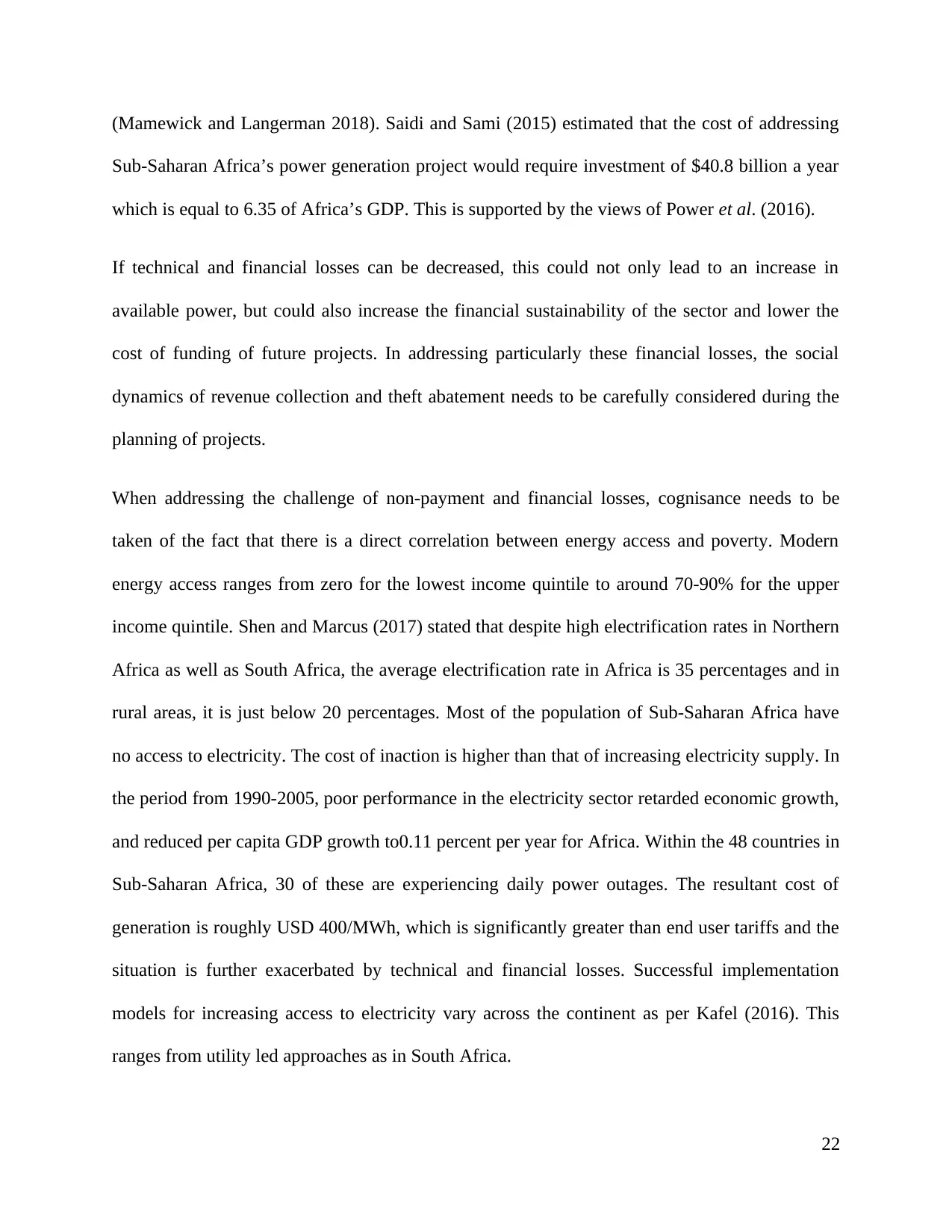
Sub-Saharan Africa’s power generation project would require investment of $40.8 billion a year
which is equal to 6.35 of Africa’s GDP. This is supported by the views of Power et al. (2016).
If technical and financial losses can be decreased, this could not only lead to an increase in
available power, but could also increase the financial sustainability of the sector and lower the
cost of funding of future projects. In addressing particularly these financial losses, the social
dynamics of revenue collection and theft abatement needs to be carefully considered during the
planning of projects.
When addressing the challenge of non-payment and financial losses, cognisance needs to be
taken of the fact that there is a direct correlation between energy access and poverty. Modern
energy access ranges from zero for the lowest income quintile to around 70-90% for the upper
income quintile. Shen and Marcus (2017) stated that despite high electrification rates in Northern
Africa as well as South Africa, the average electrification rate in Africa is 35 percentages and in
rural areas, it is just below 20 percentages. Most of the population of Sub-Saharan Africa have
no access to electricity. The cost of inaction is higher than that of increasing electricity supply. In
the period from 1990-2005, poor performance in the electricity sector retarded economic growth,
and reduced per capita GDP growth to0.11 percent per year for Africa. Within the 48 countries in
Sub-Saharan Africa, 30 of these are experiencing daily power outages. The resultant cost of
generation is roughly USD 400/MWh, which is significantly greater than end user tariffs and the
situation is further exacerbated by technical and financial losses. Successful implementation
models for increasing access to electricity vary across the continent as per Kafel (2016). This
ranges from utility led approaches as in South Africa.
22
Paraphrase This Document

electricity undermine the sustainability of electrification programs and how lack of access to
electricity increases poverty. This is often compounded by challenges related to governance and
corruption within utilities that further hamper growth in electricity supply. Grimm, Hofstetter
and Sarkis (2016) has shown that many North African countries prefer to sell excess electricity
to Europe, rather than to Sub-Saharan countries, even if suitable interconnectors between North
and South was available. It is interesting to note that 15% of the current European electricity
demand is equivalent to 15% of the projected African electricity production in the year 2050
(Abousnina et al. 2015). Careful consideration should be given to the management of
particularly the financial and social but also the environmental components of dealing with
technical and financial losses during the development of power generation projects.
2.4 Review of sustainability standards
There is some ambiguity in literature with regards to the use of standards related to the
management of sustainability particularly pertaining to power generation projects. One of the
main reasons for this is that typically sustainability standards and criteria have been associated
with the optimisation of power efficiency as well as for the effectiveness of power generation
technologies. The focus of this study is on the identification the management of sustainability in
the development of power generation projects. Visser and Tolhurst (2017) described
sustainability standards as promoted sustainable practices in the power generation sector that
support economic growth and organisational productivity. Zhou, Li and Huang (2015) discussed
that sustainability standards are focused on the environmental performance of power generation
projects. For the purposes of this study, sustainability encompasses all three legs of sustainability
– financial, social and environmental – as well as the interaction between these. Standards used
23
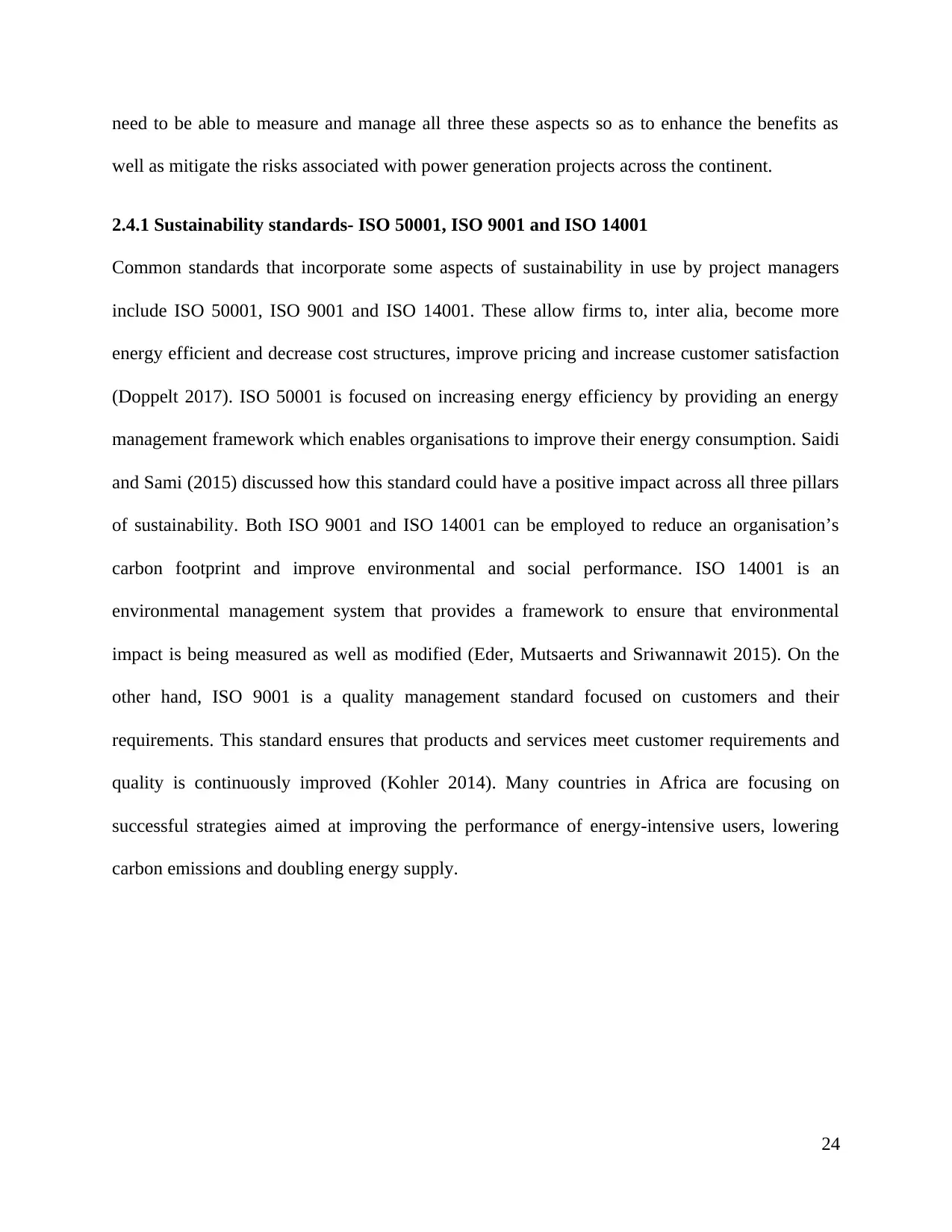
well as mitigate the risks associated with power generation projects across the continent.
2.4.1 Sustainability standards- ISO 50001, ISO 9001 and ISO 14001
Common standards that incorporate some aspects of sustainability in use by project managers
include ISO 50001, ISO 9001 and ISO 14001. These allow firms to, inter alia, become more
energy efficient and decrease cost structures, improve pricing and increase customer satisfaction
(Doppelt 2017). ISO 50001 is focused on increasing energy efficiency by providing an energy
management framework which enables organisations to improve their energy consumption. Saidi
and Sami (2015) discussed how this standard could have a positive impact across all three pillars
of sustainability. Both ISO 9001 and ISO 14001 can be employed to reduce an organisation’s
carbon footprint and improve environmental and social performance. ISO 14001 is an
environmental management system that provides a framework to ensure that environmental
impact is being measured as well as modified (Eder, Mutsaerts and Sriwannawit 2015). On the
other hand, ISO 9001 is a quality management standard focused on customers and their
requirements. This standard ensures that products and services meet customer requirements and
quality is continuously improved (Kohler 2014). Many countries in Africa are focusing on
successful strategies aimed at improving the performance of energy-intensive users, lowering
carbon emissions and doubling energy supply.
24
⊘ This is a preview!⊘
Do you want full access?
Subscribe today to unlock all pages.

Trusted by 1+ million students worldwide
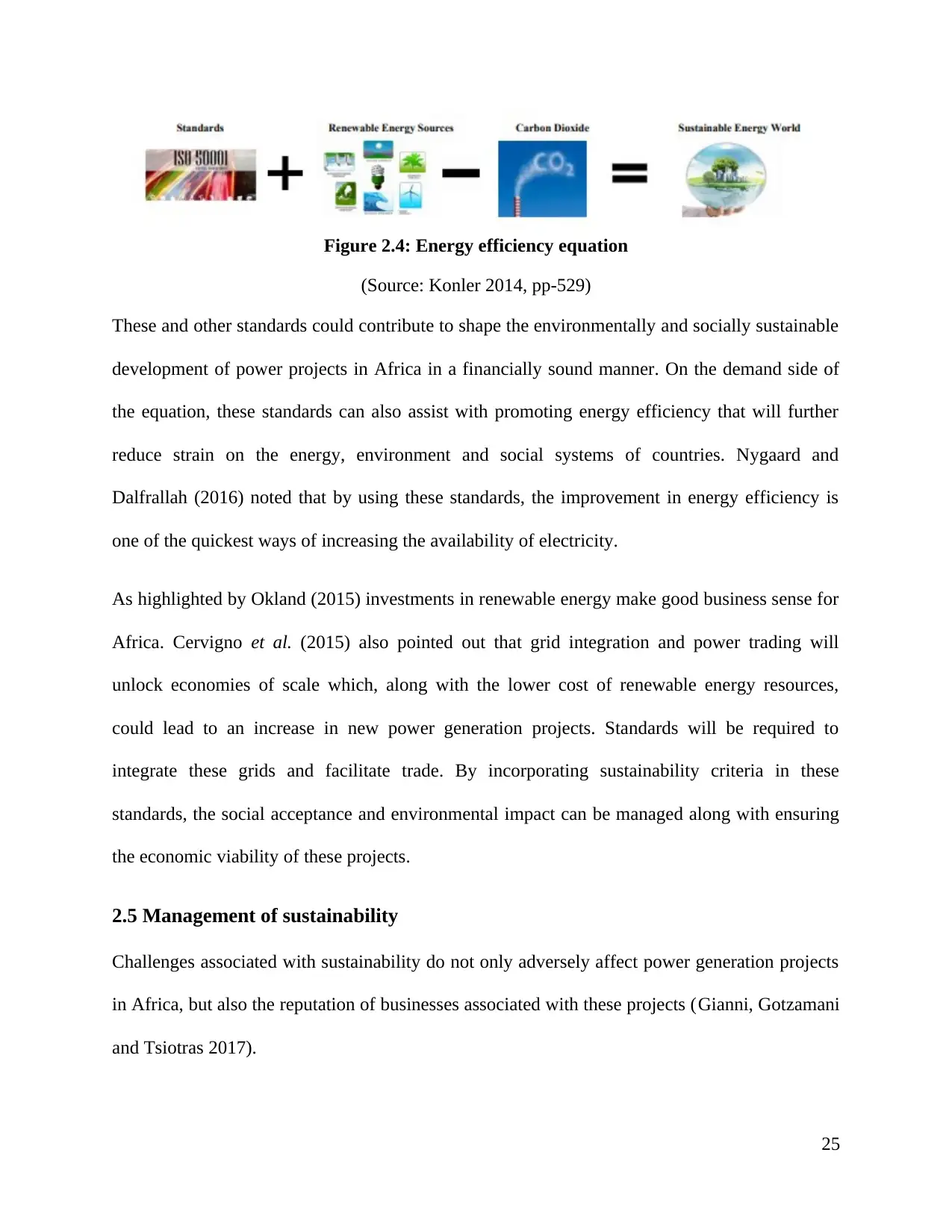
(Source: Konler 2014, pp-529)
These and other standards could contribute to shape the environmentally and socially sustainable
development of power projects in Africa in a financially sound manner. On the demand side of
the equation, these standards can also assist with promoting energy efficiency that will further
reduce strain on the energy, environment and social systems of countries. Nygaard and
Dalfrallah (2016) noted that by using these standards, the improvement in energy efficiency is
one of the quickest ways of increasing the availability of electricity.
As highlighted by Okland (2015) investments in renewable energy make good business sense for
Africa. Cervigno et al. (2015) also pointed out that grid integration and power trading will
unlock economies of scale which, along with the lower cost of renewable energy resources,
could lead to an increase in new power generation projects. Standards will be required to
integrate these grids and facilitate trade. By incorporating sustainability criteria in these
standards, the social acceptance and environmental impact can be managed along with ensuring
the economic viability of these projects.
2.5 Management of sustainability
Challenges associated with sustainability do not only adversely affect power generation projects
in Africa, but also the reputation of businesses associated with these projects (Gianni, Gotzamani
and Tsiotras 2017).
25
Paraphrase This Document
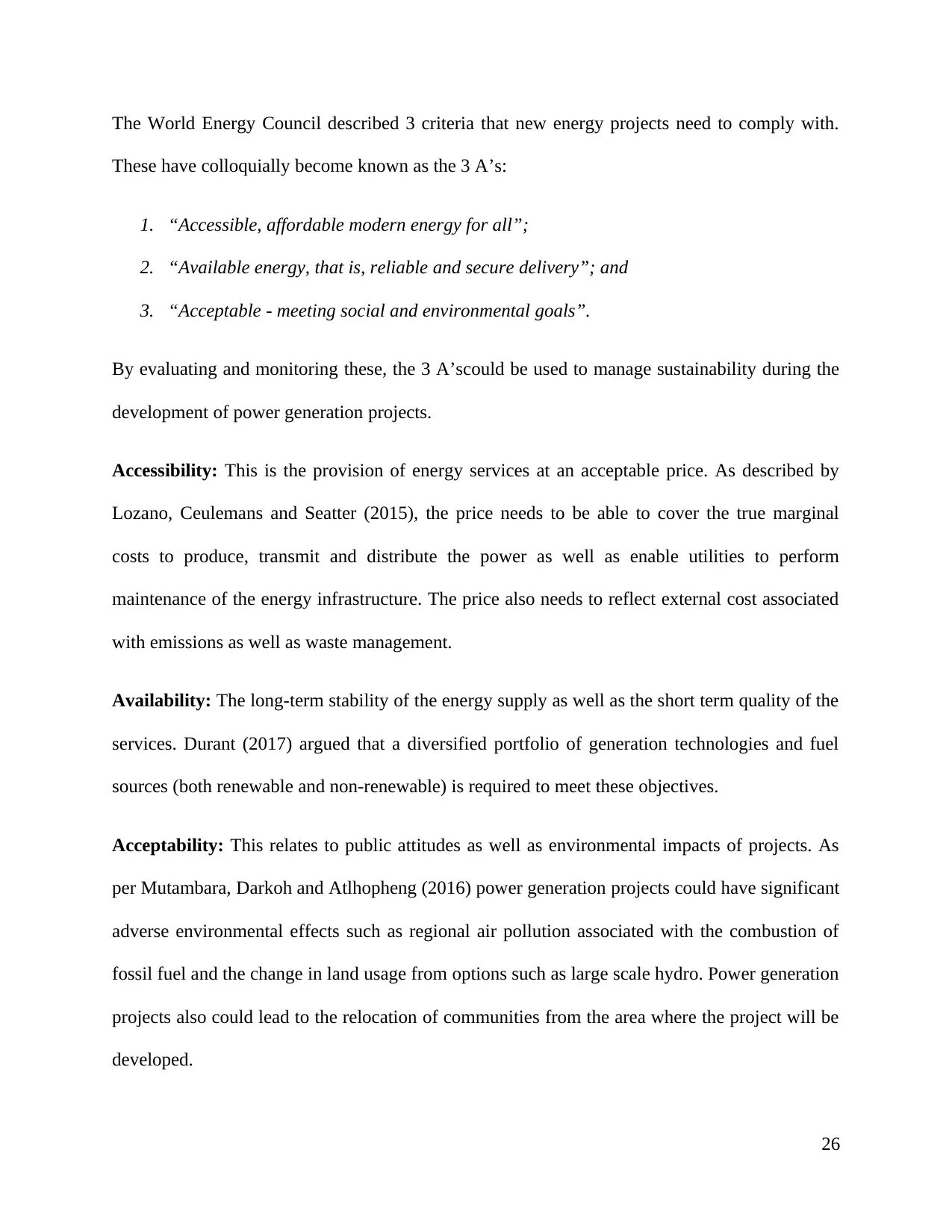
These have colloquially become known as the 3 A’s:
1. “Accessible, affordable modern energy for all”;
2. “Available energy, that is, reliable and secure delivery”; and
3. “Acceptable - meeting social and environmental goals”.
By evaluating and monitoring these, the 3 A’scould be used to manage sustainability during the
development of power generation projects.
Accessibility: This is the provision of energy services at an acceptable price. As described by
Lozano, Ceulemans and Seatter (2015), the price needs to be able to cover the true marginal
costs to produce, transmit and distribute the power as well as enable utilities to perform
maintenance of the energy infrastructure. The price also needs to reflect external cost associated
with emissions as well as waste management.
Availability: The long-term stability of the energy supply as well as the short term quality of the
services. Durant (2017) argued that a diversified portfolio of generation technologies and fuel
sources (both renewable and non-renewable) is required to meet these objectives.
Acceptability: This relates to public attitudes as well as environmental impacts of projects. As
per Mutambara, Darkoh and Atlhopheng (2016) power generation projects could have significant
adverse environmental effects such as regional air pollution associated with the combustion of
fossil fuel and the change in land usage from options such as large scale hydro. Power generation
projects also could lead to the relocation of communities from the area where the project will be
developed.
26

managing sustainability during the development of new projects. The three indicators above
were selected to fit the research objectives of this study. A summary of the selected sustainability
indicators is shown in table below (map to GRI).
Indicators Accessibility Availability Acceptability
Economic factors
Direct cost and economical benefits 0 1 19
Employment 0 0 3
Flexibility 0 0 0
Social factors
Health and safety impacts 0 0 10
Displacement of communities 0 1 8
Human rights 0 0 1
Labor practices 0 0 1
Environmental factors
Air quality 0 0 5
Water usage 0 0 0
Land usage 0 0 1
Biodiversity impacts 0 0 17
27
⊘ This is a preview!⊘
Do you want full access?
Subscribe today to unlock all pages.

Trusted by 1+ million students worldwide
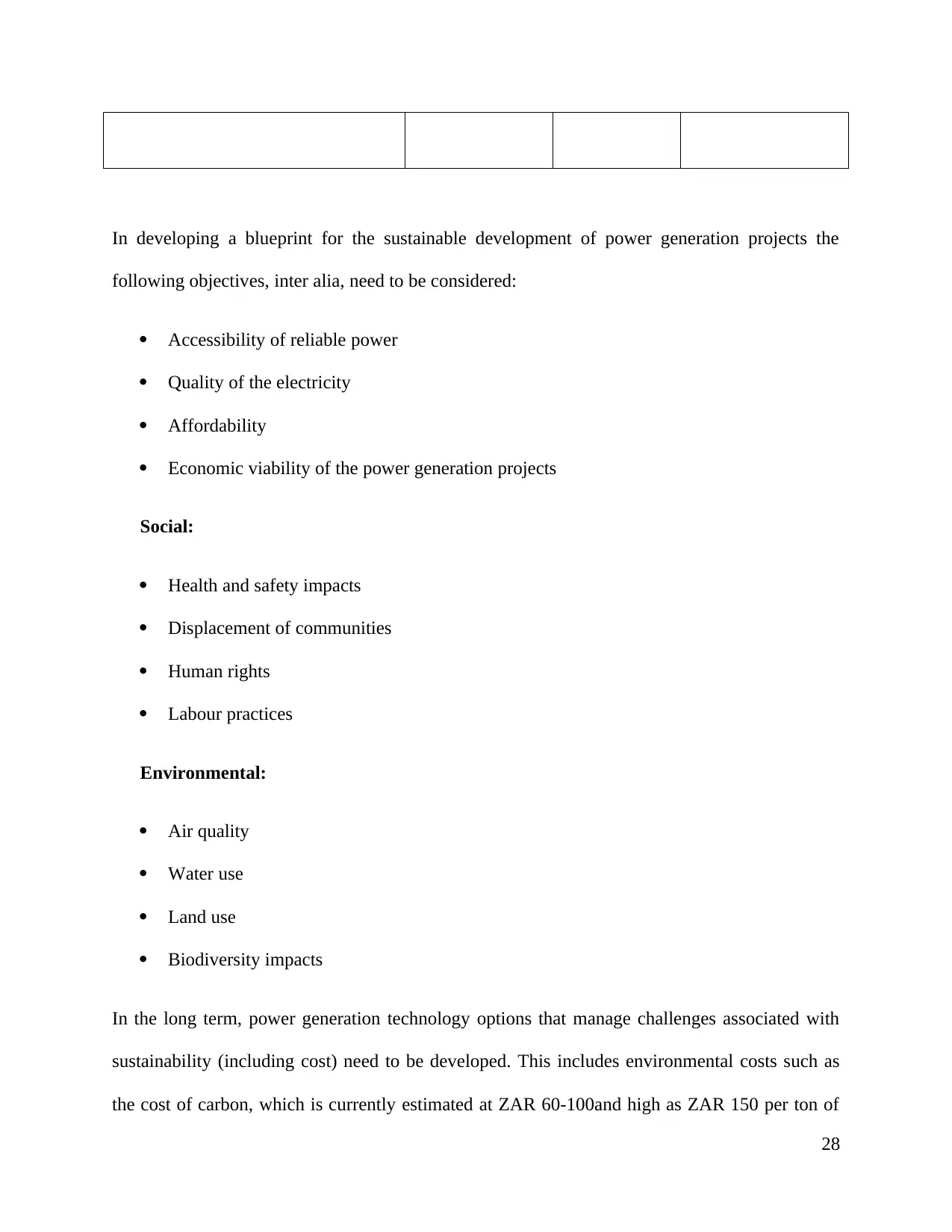
following objectives, inter alia, need to be considered:
Accessibility of reliable power
Quality of the electricity
Affordability
Economic viability of the power generation projects
Social:
Health and safety impacts
Displacement of communities
Human rights
Labour practices
Environmental:
Air quality
Water use
Land use
Biodiversity impacts
In the long term, power generation technology options that manage challenges associated with
sustainability (including cost) need to be developed. This includes environmental costs such as
the cost of carbon, which is currently estimated at ZAR 60-100and high as ZAR 150 per ton of
28
Paraphrase This Document
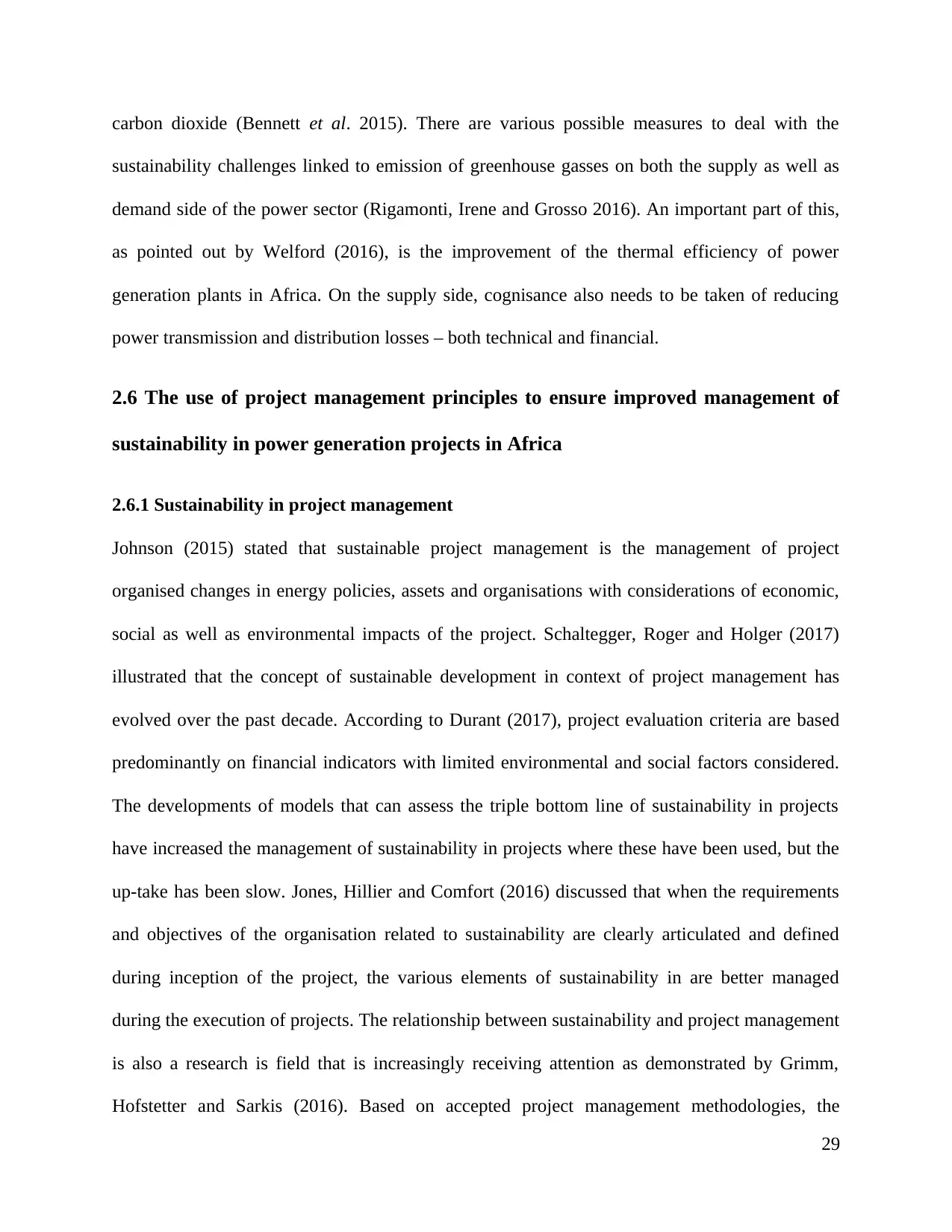
sustainability challenges linked to emission of greenhouse gasses on both the supply as well as
demand side of the power sector (Rigamonti, Irene and Grosso 2016). An important part of this,
as pointed out by Welford (2016), is the improvement of the thermal efficiency of power
generation plants in Africa. On the supply side, cognisance also needs to be taken of reducing
power transmission and distribution losses – both technical and financial.
2.6 The use of project management principles to ensure improved management of
sustainability in power generation projects in Africa
2.6.1 Sustainability in project management
Johnson (2015) stated that sustainable project management is the management of project
organised changes in energy policies, assets and organisations with considerations of economic,
social as well as environmental impacts of the project. Schaltegger, Roger and Holger (2017)
illustrated that the concept of sustainable development in context of project management has
evolved over the past decade. According to Durant (2017), project evaluation criteria are based
predominantly on financial indicators with limited environmental and social factors considered.
The developments of models that can assess the triple bottom line of sustainability in projects
have increased the management of sustainability in projects where these have been used, but the
up-take has been slow. Jones, Hillier and Comfort (2016) discussed that when the requirements
and objectives of the organisation related to sustainability are clearly articulated and defined
during inception of the project, the various elements of sustainability in are better managed
during the execution of projects. The relationship between sustainability and project management
is also a research is field that is increasingly receiving attention as demonstrated by Grimm,
Hofstetter and Sarkis (2016). Based on accepted project management methodologies, the
29
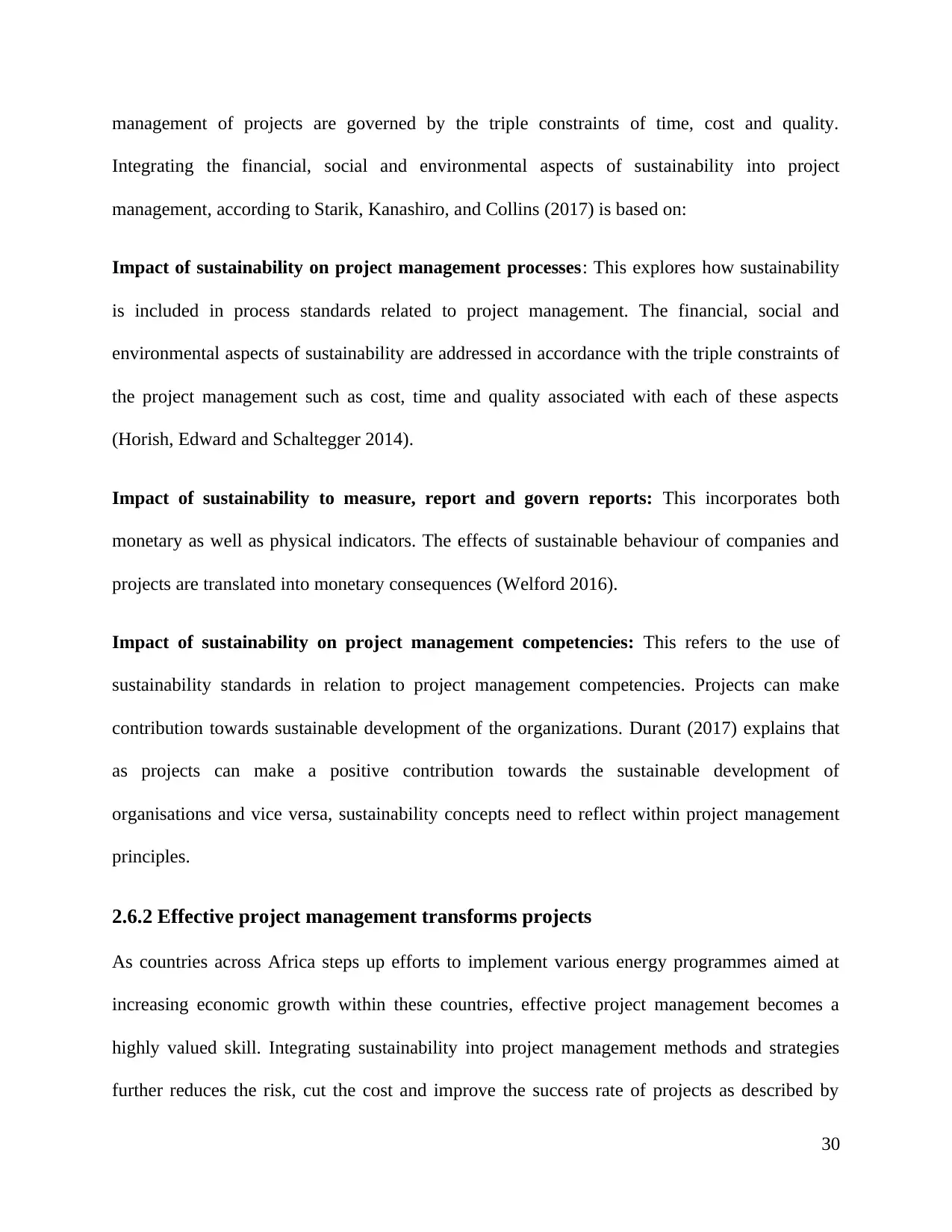
Integrating the financial, social and environmental aspects of sustainability into project
management, according to Starik, Kanashiro, and Collins (2017) is based on:
Impact of sustainability on project management processes: This explores how sustainability
is included in process standards related to project management. The financial, social and
environmental aspects of sustainability are addressed in accordance with the triple constraints of
the project management such as cost, time and quality associated with each of these aspects
(Horish, Edward and Schaltegger 2014).
Impact of sustainability to measure, report and govern reports: This incorporates both
monetary as well as physical indicators. The effects of sustainable behaviour of companies and
projects are translated into monetary consequences (Welford 2016).
Impact of sustainability on project management competencies: This refers to the use of
sustainability standards in relation to project management competencies. Projects can make
contribution towards sustainable development of the organizations. Durant (2017) explains that
as projects can make a positive contribution towards the sustainable development of
organisations and vice versa, sustainability concepts need to reflect within project management
principles.
2.6.2 Effective project management transforms projects
As countries across Africa steps up efforts to implement various energy programmes aimed at
increasing economic growth within these countries, effective project management becomes a
highly valued skill. Integrating sustainability into project management methods and strategies
further reduces the risk, cut the cost and improve the success rate of projects as described by
30
⊘ This is a preview!⊘
Do you want full access?
Subscribe today to unlock all pages.

Trusted by 1+ million students worldwide
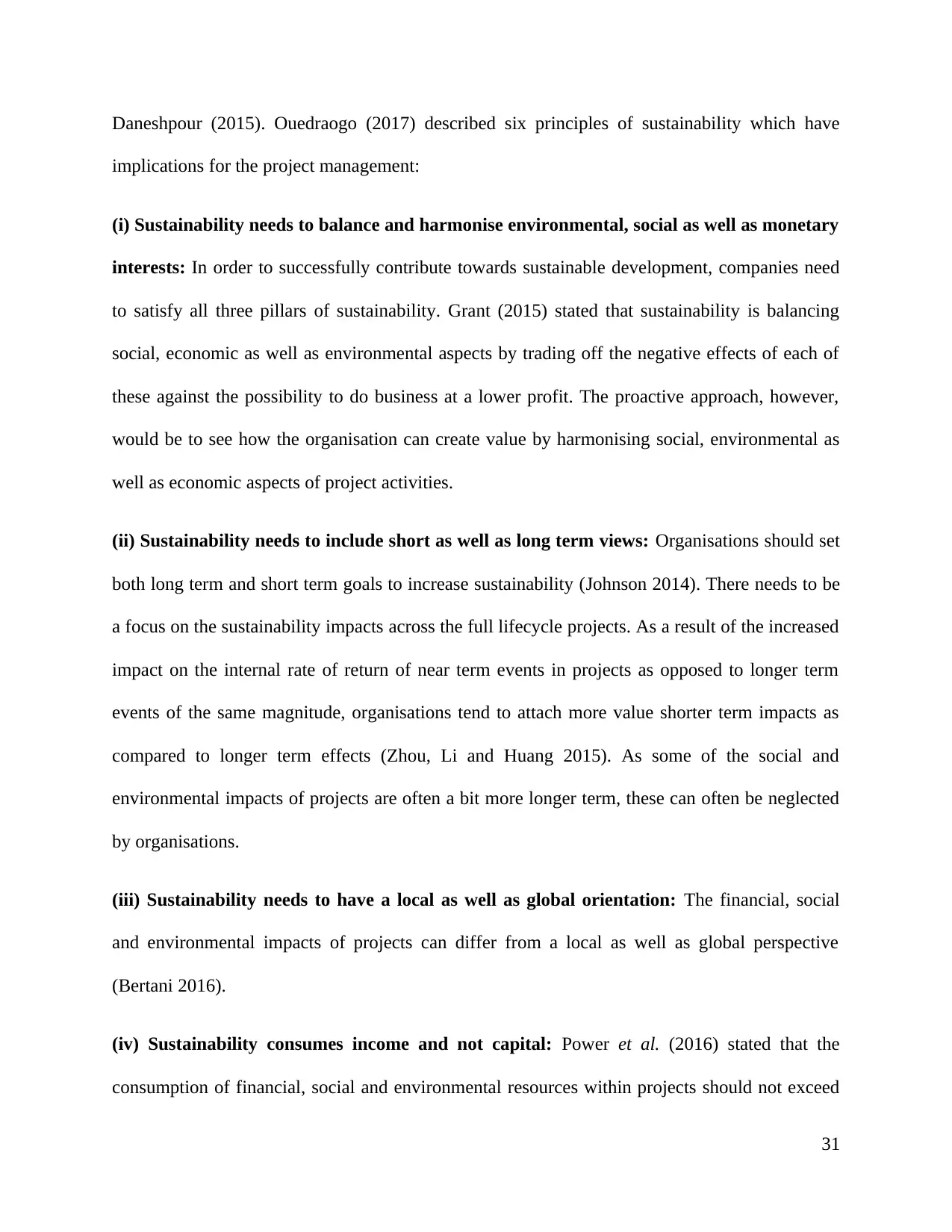
implications for the project management:
(i) Sustainability needs to balance and harmonise environmental, social as well as monetary
interests: In order to successfully contribute towards sustainable development, companies need
to satisfy all three pillars of sustainability. Grant (2015) stated that sustainability is balancing
social, economic as well as environmental aspects by trading off the negative effects of each of
these against the possibility to do business at a lower profit. The proactive approach, however,
would be to see how the organisation can create value by harmonising social, environmental as
well as economic aspects of project activities.
(ii) Sustainability needs to include short as well as long term views: Organisations should set
both long term and short term goals to increase sustainability (Johnson 2014). There needs to be
a focus on the sustainability impacts across the full lifecycle projects. As a result of the increased
impact on the internal rate of return of near term events in projects as opposed to longer term
events of the same magnitude, organisations tend to attach more value shorter term impacts as
compared to longer term effects (Zhou, Li and Huang 2015). As some of the social and
environmental impacts of projects are often a bit more longer term, these can often be neglected
by organisations.
(iii) Sustainability needs to have a local as well as global orientation: The financial, social
and environmental impacts of projects can differ from a local as well as global perspective
(Bertani 2016).
(iv) Sustainability consumes income and not capital: Power et al. (2016) stated that the
consumption of financial, social and environmental resources within projects should not exceed
31
Paraphrase This Document
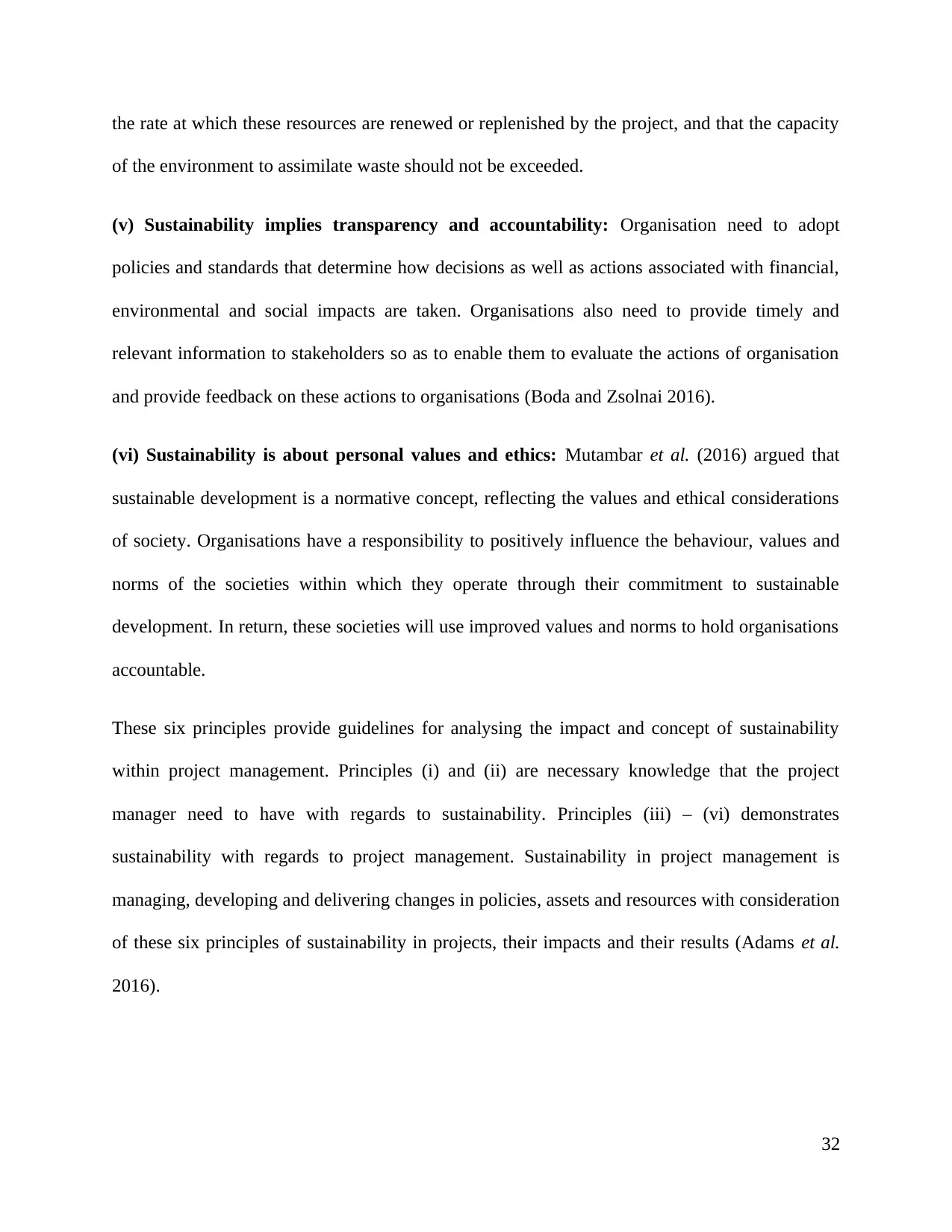
of the environment to assimilate waste should not be exceeded.
(v) Sustainability implies transparency and accountability: Organisation need to adopt
policies and standards that determine how decisions as well as actions associated with financial,
environmental and social impacts are taken. Organisations also need to provide timely and
relevant information to stakeholders so as to enable them to evaluate the actions of organisation
and provide feedback on these actions to organisations (Boda and Zsolnai 2016).
(vi) Sustainability is about personal values and ethics: Mutambar et al. (2016) argued that
sustainable development is a normative concept, reflecting the values and ethical considerations
of society. Organisations have a responsibility to positively influence the behaviour, values and
norms of the societies within which they operate through their commitment to sustainable
development. In return, these societies will use improved values and norms to hold organisations
accountable.
These six principles provide guidelines for analysing the impact and concept of sustainability
within project management. Principles (i) and (ii) are necessary knowledge that the project
manager need to have with regards to sustainability. Principles (iii) – (vi) demonstrates
sustainability with regards to project management. Sustainability in project management is
managing, developing and delivering changes in policies, assets and resources with consideration
of these six principles of sustainability in projects, their impacts and their results (Adams et al.
2016).
32
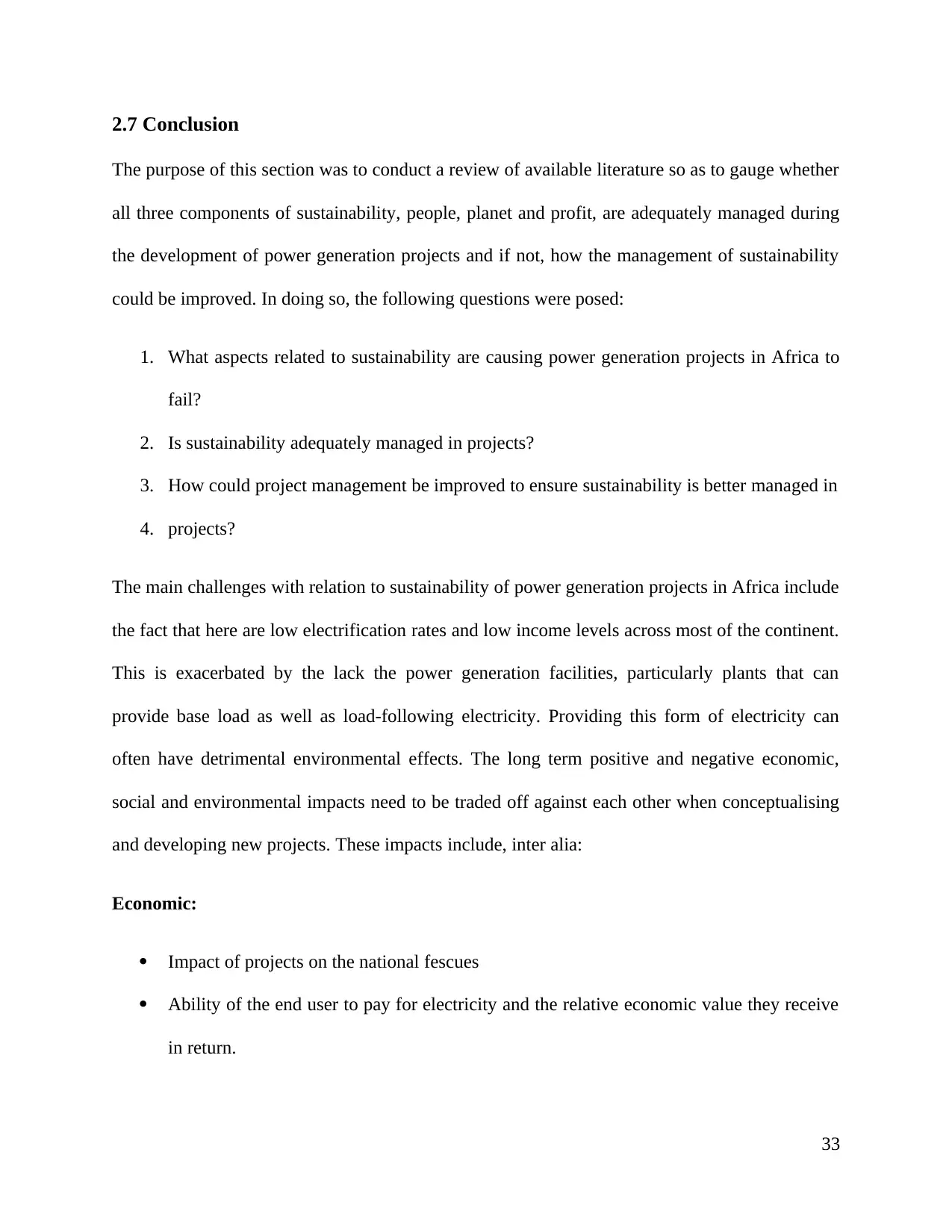
The purpose of this section was to conduct a review of available literature so as to gauge whether
all three components of sustainability, people, planet and profit, are adequately managed during
the development of power generation projects and if not, how the management of sustainability
could be improved. In doing so, the following questions were posed:
1. What aspects related to sustainability are causing power generation projects in Africa to
fail?
2. Is sustainability adequately managed in projects?
3. How could project management be improved to ensure sustainability is better managed in
4. projects?
The main challenges with relation to sustainability of power generation projects in Africa include
the fact that here are low electrification rates and low income levels across most of the continent.
This is exacerbated by the lack the power generation facilities, particularly plants that can
provide base load as well as load-following electricity. Providing this form of electricity can
often have detrimental environmental effects. The long term positive and negative economic,
social and environmental impacts need to be traded off against each other when conceptualising
and developing new projects. These impacts include, inter alia:
Economic:
Impact of projects on the national fescues
Ability of the end user to pay for electricity and the relative economic value they receive
in return.
33
⊘ This is a preview!⊘
Do you want full access?
Subscribe today to unlock all pages.

Trusted by 1+ million students worldwide
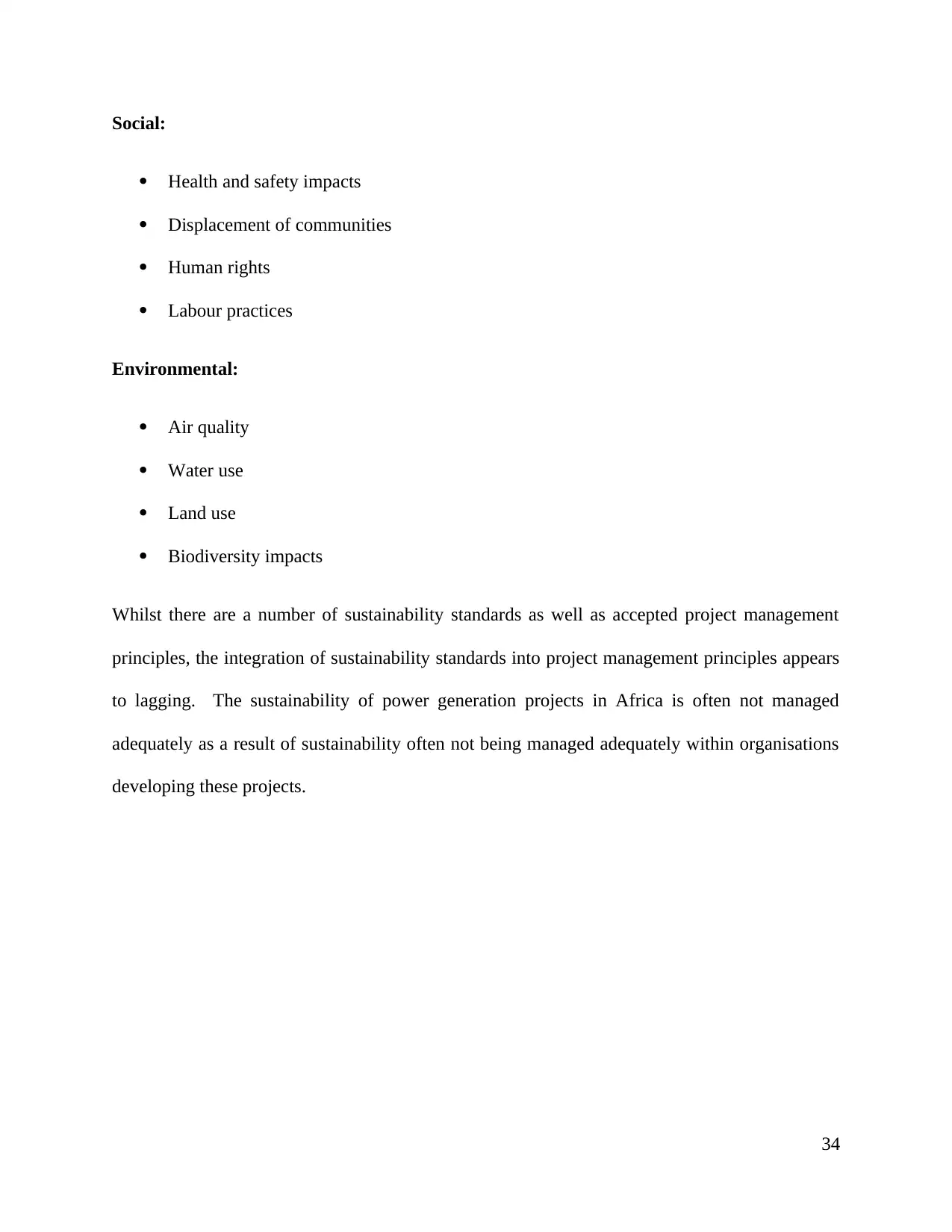
Health and safety impacts
Displacement of communities
Human rights
Labour practices
Environmental:
Air quality
Water use
Land use
Biodiversity impacts
Whilst there are a number of sustainability standards as well as accepted project management
principles, the integration of sustainability standards into project management principles appears
to lagging. The sustainability of power generation projects in Africa is often not managed
adequately as a result of sustainability often not being managed adequately within organisations
developing these projects.
34
Paraphrase This Document
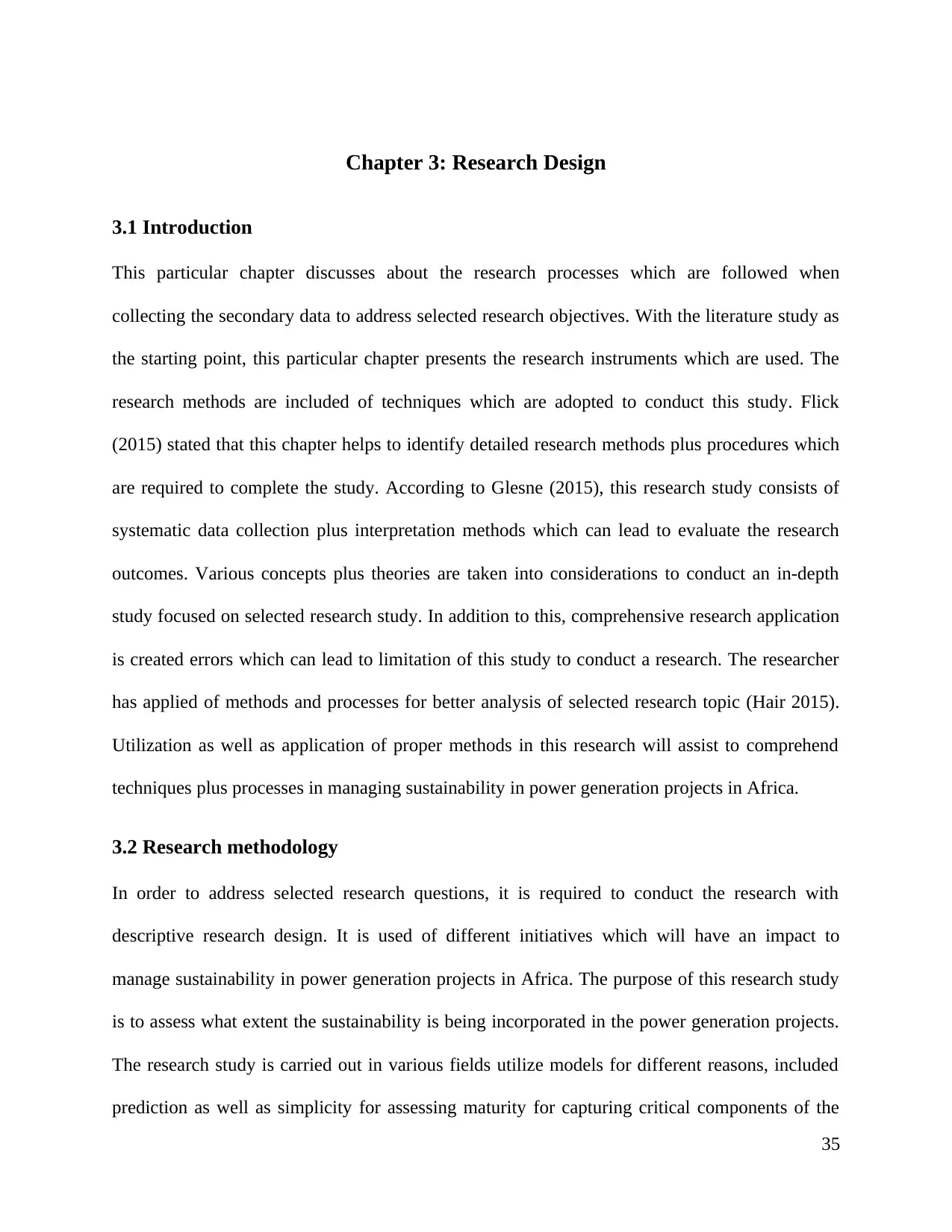
3.1 Introduction
This particular chapter discusses about the research processes which are followed when
collecting the secondary data to address selected research objectives. With the literature study as
the starting point, this particular chapter presents the research instruments which are used. The
research methods are included of techniques which are adopted to conduct this study. Flick
(2015) stated that this chapter helps to identify detailed research methods plus procedures which
are required to complete the study. According to Glesne (2015), this research study consists of
systematic data collection plus interpretation methods which can lead to evaluate the research
outcomes. Various concepts plus theories are taken into considerations to conduct an in-depth
study focused on selected research study. In addition to this, comprehensive research application
is created errors which can lead to limitation of this study to conduct a research. The researcher
has applied of methods and processes for better analysis of selected research topic (Hair 2015).
Utilization as well as application of proper methods in this research will assist to comprehend
techniques plus processes in managing sustainability in power generation projects in Africa.
3.2 Research methodology
In order to address selected research questions, it is required to conduct the research with
descriptive research design. It is used of different initiatives which will have an impact to
manage sustainability in power generation projects in Africa. The purpose of this research study
is to assess what extent the sustainability is being incorporated in the power generation projects.
The research study is carried out in various fields utilize models for different reasons, included
prediction as well as simplicity for assessing maturity for capturing critical components of the
35
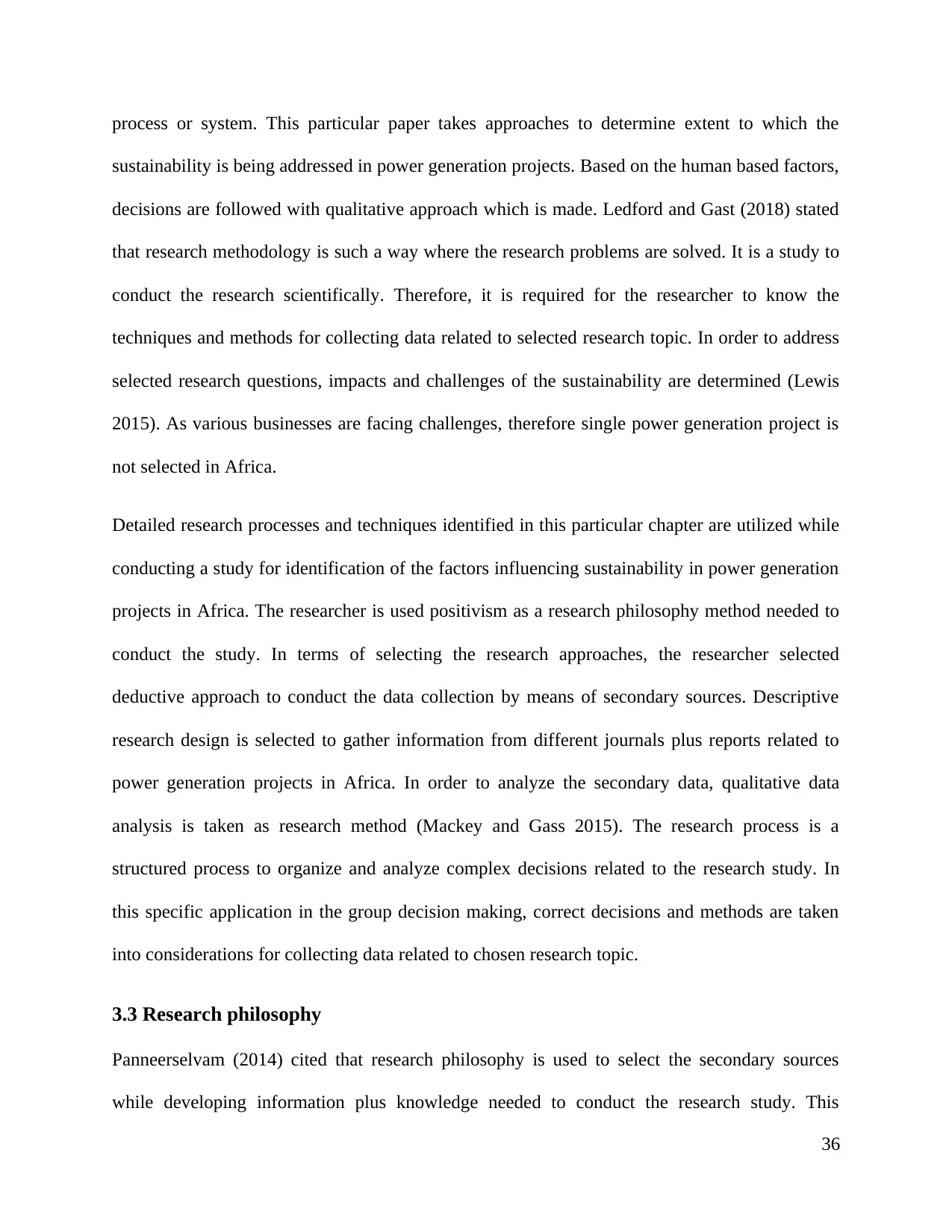
sustainability is being addressed in power generation projects. Based on the human based factors,
decisions are followed with qualitative approach which is made. Ledford and Gast (2018) stated
that research methodology is such a way where the research problems are solved. It is a study to
conduct the research scientifically. Therefore, it is required for the researcher to know the
techniques and methods for collecting data related to selected research topic. In order to address
selected research questions, impacts and challenges of the sustainability are determined (Lewis
2015). As various businesses are facing challenges, therefore single power generation project is
not selected in Africa.
Detailed research processes and techniques identified in this particular chapter are utilized while
conducting a study for identification of the factors influencing sustainability in power generation
projects in Africa. The researcher is used positivism as a research philosophy method needed to
conduct the study. In terms of selecting the research approaches, the researcher selected
deductive approach to conduct the data collection by means of secondary sources. Descriptive
research design is selected to gather information from different journals plus reports related to
power generation projects in Africa. In order to analyze the secondary data, qualitative data
analysis is taken as research method (Mackey and Gass 2015). The research process is a
structured process to organize and analyze complex decisions related to the research study. In
this specific application in the group decision making, correct decisions and methods are taken
into considerations for collecting data related to chosen research topic.
3.3 Research philosophy
Panneerselvam (2014) cited that research philosophy is used to select the secondary sources
while developing information plus knowledge needed to conduct the research study. This
36
⊘ This is a preview!⊘
Do you want full access?
Subscribe today to unlock all pages.

Trusted by 1+ million students worldwide
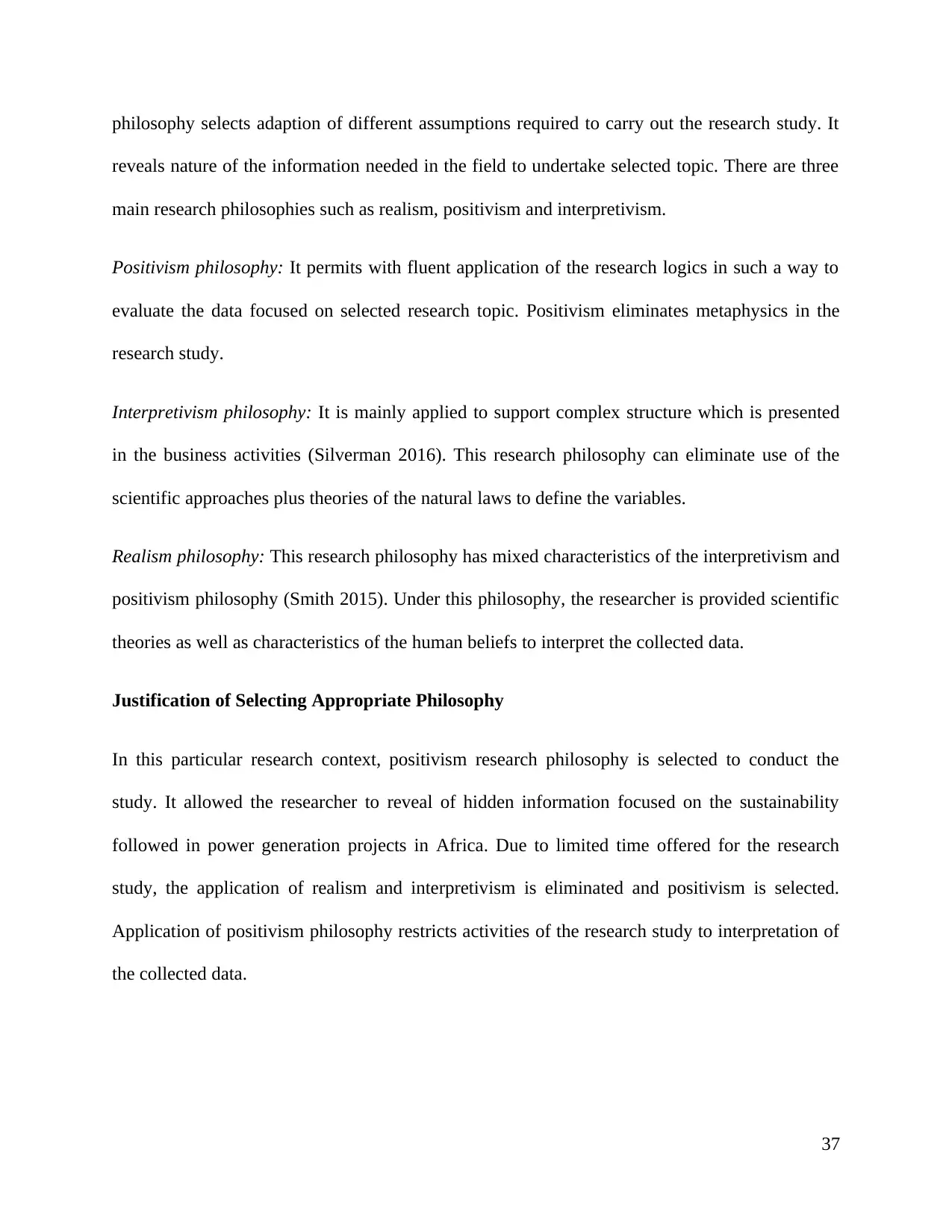
reveals nature of the information needed in the field to undertake selected topic. There are three
main research philosophies such as realism, positivism and interpretivism.
Positivism philosophy: It permits with fluent application of the research logics in such a way to
evaluate the data focused on selected research topic. Positivism eliminates metaphysics in the
research study.
Interpretivism philosophy: It is mainly applied to support complex structure which is presented
in the business activities (Silverman 2016). This research philosophy can eliminate use of the
scientific approaches plus theories of the natural laws to define the variables.
Realism philosophy: This research philosophy has mixed characteristics of the interpretivism and
positivism philosophy (Smith 2015). Under this philosophy, the researcher is provided scientific
theories as well as characteristics of the human beliefs to interpret the collected data.
Justification of Selecting Appropriate Philosophy
In this particular research context, positivism research philosophy is selected to conduct the
study. It allowed the researcher to reveal of hidden information focused on the sustainability
followed in power generation projects in Africa. Due to limited time offered for the research
study, the application of realism and interpretivism is eliminated and positivism is selected.
Application of positivism philosophy restricts activities of the research study to interpretation of
the collected data.
37
Paraphrase This Document
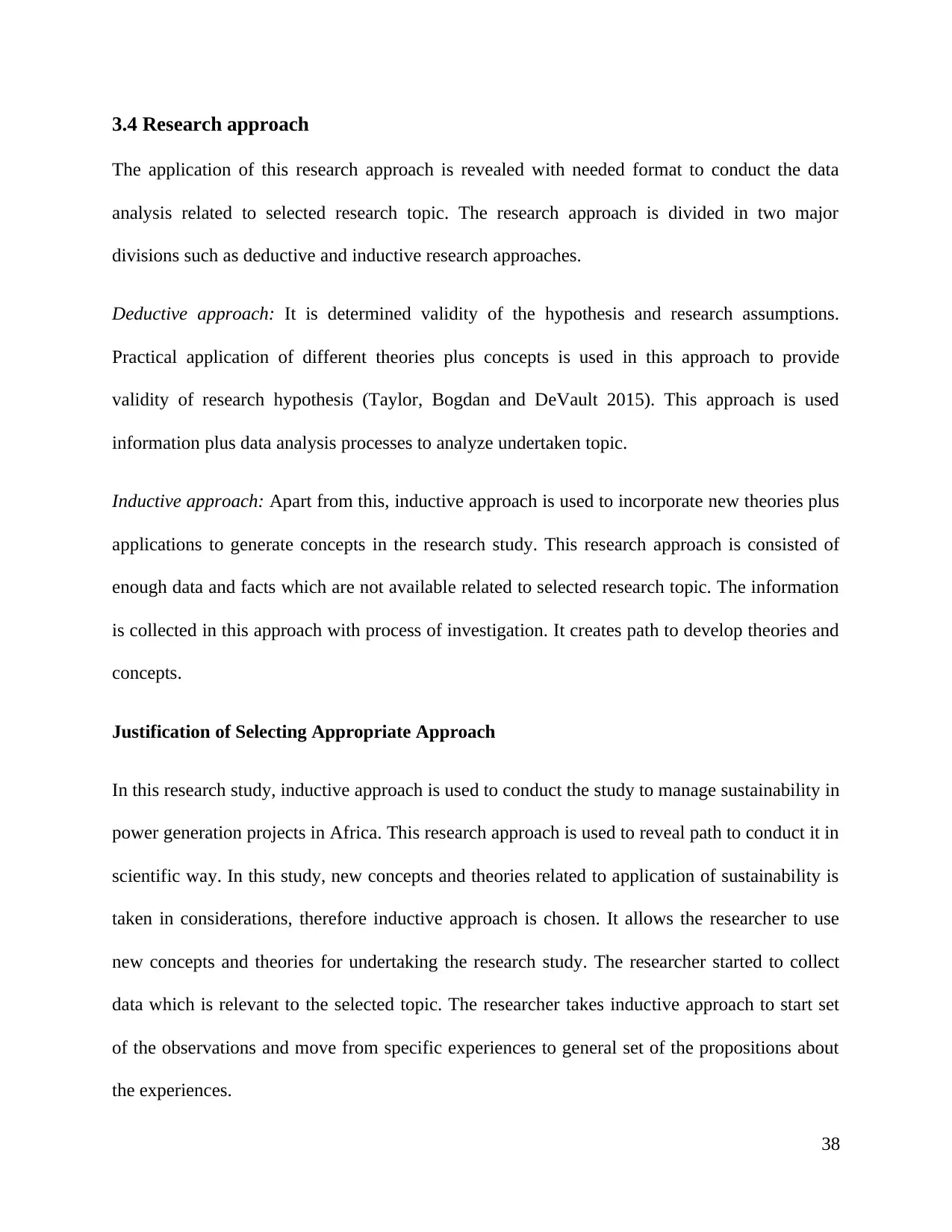
The application of this research approach is revealed with needed format to conduct the data
analysis related to selected research topic. The research approach is divided in two major
divisions such as deductive and inductive research approaches.
Deductive approach: It is determined validity of the hypothesis and research assumptions.
Practical application of different theories plus concepts is used in this approach to provide
validity of research hypothesis (Taylor, Bogdan and DeVault 2015). This approach is used
information plus data analysis processes to analyze undertaken topic.
Inductive approach: Apart from this, inductive approach is used to incorporate new theories plus
applications to generate concepts in the research study. This research approach is consisted of
enough data and facts which are not available related to selected research topic. The information
is collected in this approach with process of investigation. It creates path to develop theories and
concepts.
Justification of Selecting Appropriate Approach
In this research study, inductive approach is used to conduct the study to manage sustainability in
power generation projects in Africa. This research approach is used to reveal path to conduct it in
scientific way. In this study, new concepts and theories related to application of sustainability is
taken in considerations, therefore inductive approach is chosen. It allows the researcher to use
new concepts and theories for undertaking the research study. The researcher started to collect
data which is relevant to the selected topic. The researcher takes inductive approach to start set
of the observations and move from specific experiences to general set of the propositions about
the experiences.
38
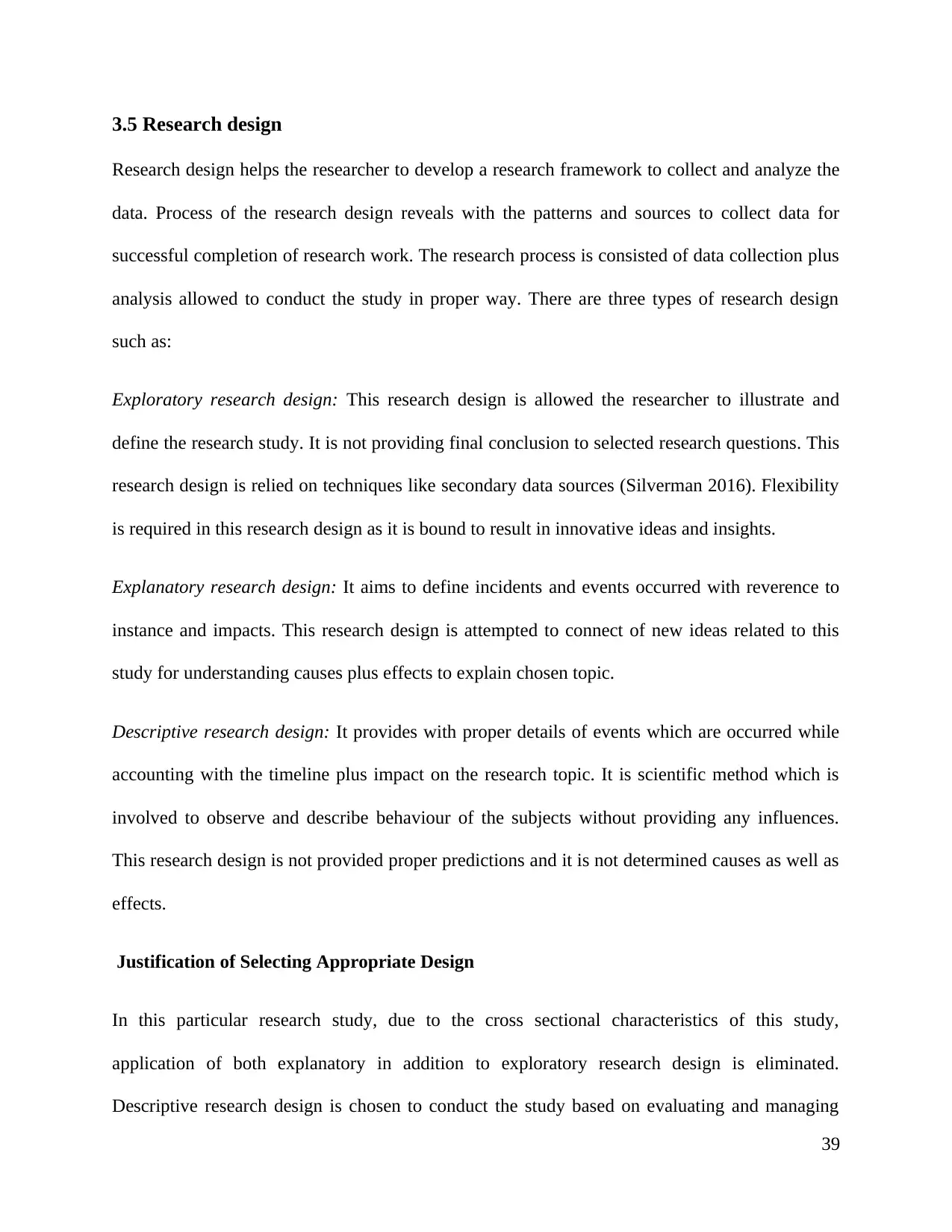
Research design helps the researcher to develop a research framework to collect and analyze the
data. Process of the research design reveals with the patterns and sources to collect data for
successful completion of research work. The research process is consisted of data collection plus
analysis allowed to conduct the study in proper way. There are three types of research design
such as:
Exploratory research design: This research design is allowed the researcher to illustrate and
define the research study. It is not providing final conclusion to selected research questions. This
research design is relied on techniques like secondary data sources (Silverman 2016). Flexibility
is required in this research design as it is bound to result in innovative ideas and insights.
Explanatory research design: It aims to define incidents and events occurred with reverence to
instance and impacts. This research design is attempted to connect of new ideas related to this
study for understanding causes plus effects to explain chosen topic.
Descriptive research design: It provides with proper details of events which are occurred while
accounting with the timeline plus impact on the research topic. It is scientific method which is
involved to observe and describe behaviour of the subjects without providing any influences.
This research design is not provided proper predictions and it is not determined causes as well as
effects.
Justification of Selecting Appropriate Design
In this particular research study, due to the cross sectional characteristics of this study,
application of both explanatory in addition to exploratory research design is eliminated.
Descriptive research design is chosen to conduct the study based on evaluating and managing
39
⊘ This is a preview!⊘
Do you want full access?
Subscribe today to unlock all pages.

Trusted by 1+ million students worldwide
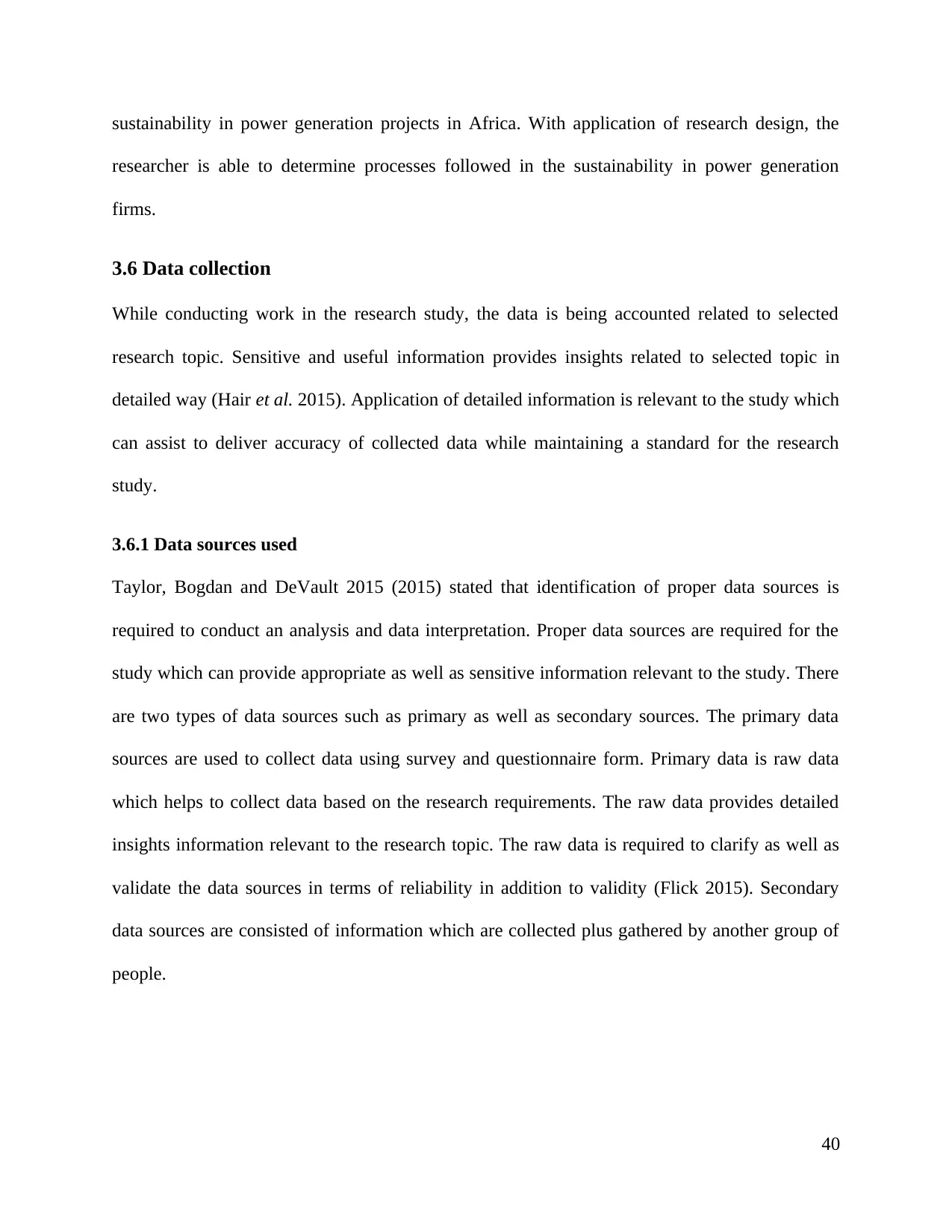
researcher is able to determine processes followed in the sustainability in power generation
firms.
3.6 Data collection
While conducting work in the research study, the data is being accounted related to selected
research topic. Sensitive and useful information provides insights related to selected topic in
detailed way (Hair et al. 2015). Application of detailed information is relevant to the study which
can assist to deliver accuracy of collected data while maintaining a standard for the research
study.
3.6.1 Data sources used
Taylor, Bogdan and DeVault 2015 (2015) stated that identification of proper data sources is
required to conduct an analysis and data interpretation. Proper data sources are required for the
study which can provide appropriate as well as sensitive information relevant to the study. There
are two types of data sources such as primary as well as secondary sources. The primary data
sources are used to collect data using survey and questionnaire form. Primary data is raw data
which helps to collect data based on the research requirements. The raw data provides detailed
insights information relevant to the research topic. The raw data is required to clarify as well as
validate the data sources in terms of reliability in addition to validity (Flick 2015). Secondary
data sources are consisted of information which are collected plus gathered by another group of
people.
40
Paraphrase This Document
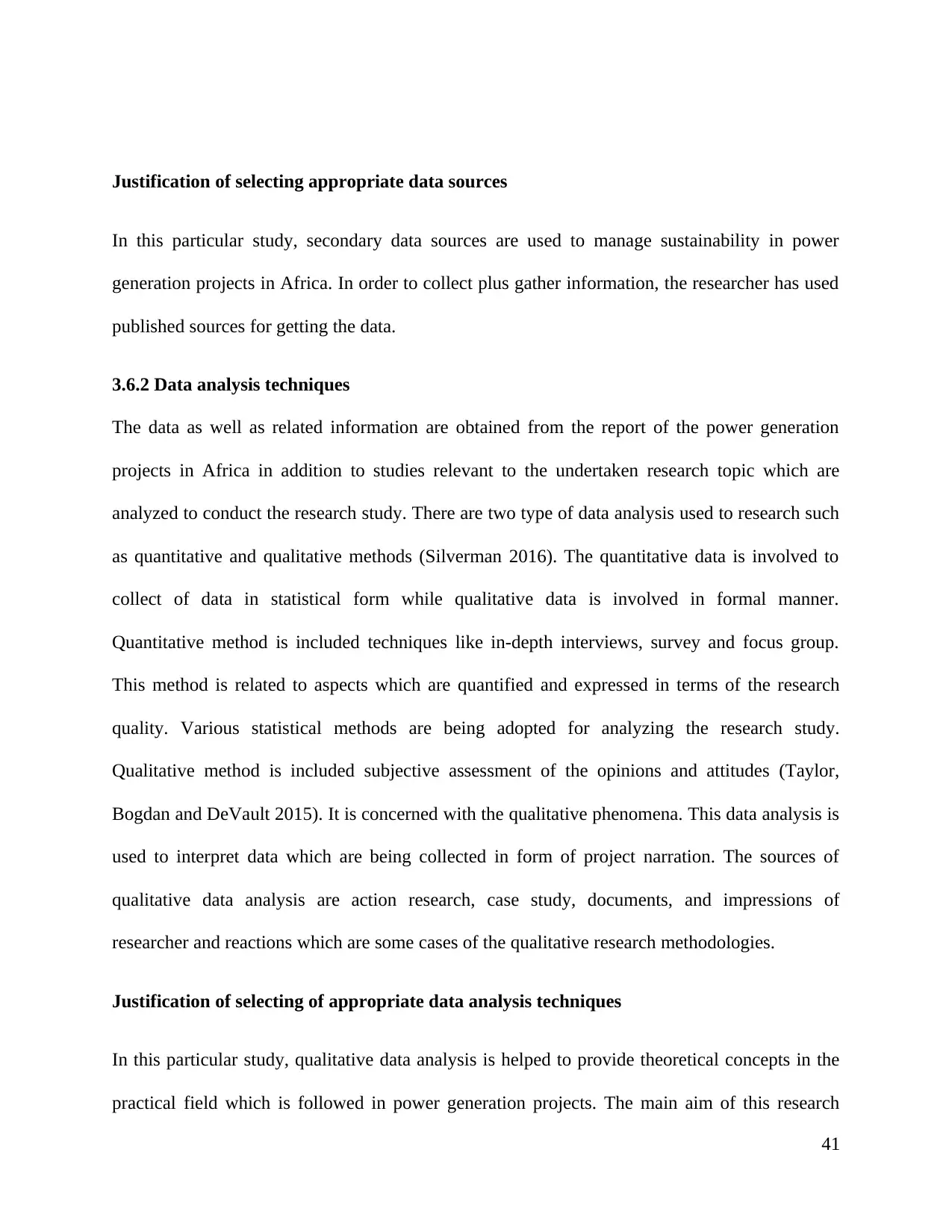
In this particular study, secondary data sources are used to manage sustainability in power
generation projects in Africa. In order to collect plus gather information, the researcher has used
published sources for getting the data.
3.6.2 Data analysis techniques
The data as well as related information are obtained from the report of the power generation
projects in Africa in addition to studies relevant to the undertaken research topic which are
analyzed to conduct the research study. There are two type of data analysis used to research such
as quantitative and qualitative methods (Silverman 2016). The quantitative data is involved to
collect of data in statistical form while qualitative data is involved in formal manner.
Quantitative method is included techniques like in-depth interviews, survey and focus group.
This method is related to aspects which are quantified and expressed in terms of the research
quality. Various statistical methods are being adopted for analyzing the research study.
Qualitative method is included subjective assessment of the opinions and attitudes (Taylor,
Bogdan and DeVault 2015). It is concerned with the qualitative phenomena. This data analysis is
used to interpret data which are being collected in form of project narration. The sources of
qualitative data analysis are action research, case study, documents, and impressions of
researcher and reactions which are some cases of the qualitative research methodologies.
Justification of selecting of appropriate data analysis techniques
In this particular study, qualitative data analysis is helped to provide theoretical concepts in the
practical field which is followed in power generation projects. The main aim of this research
41
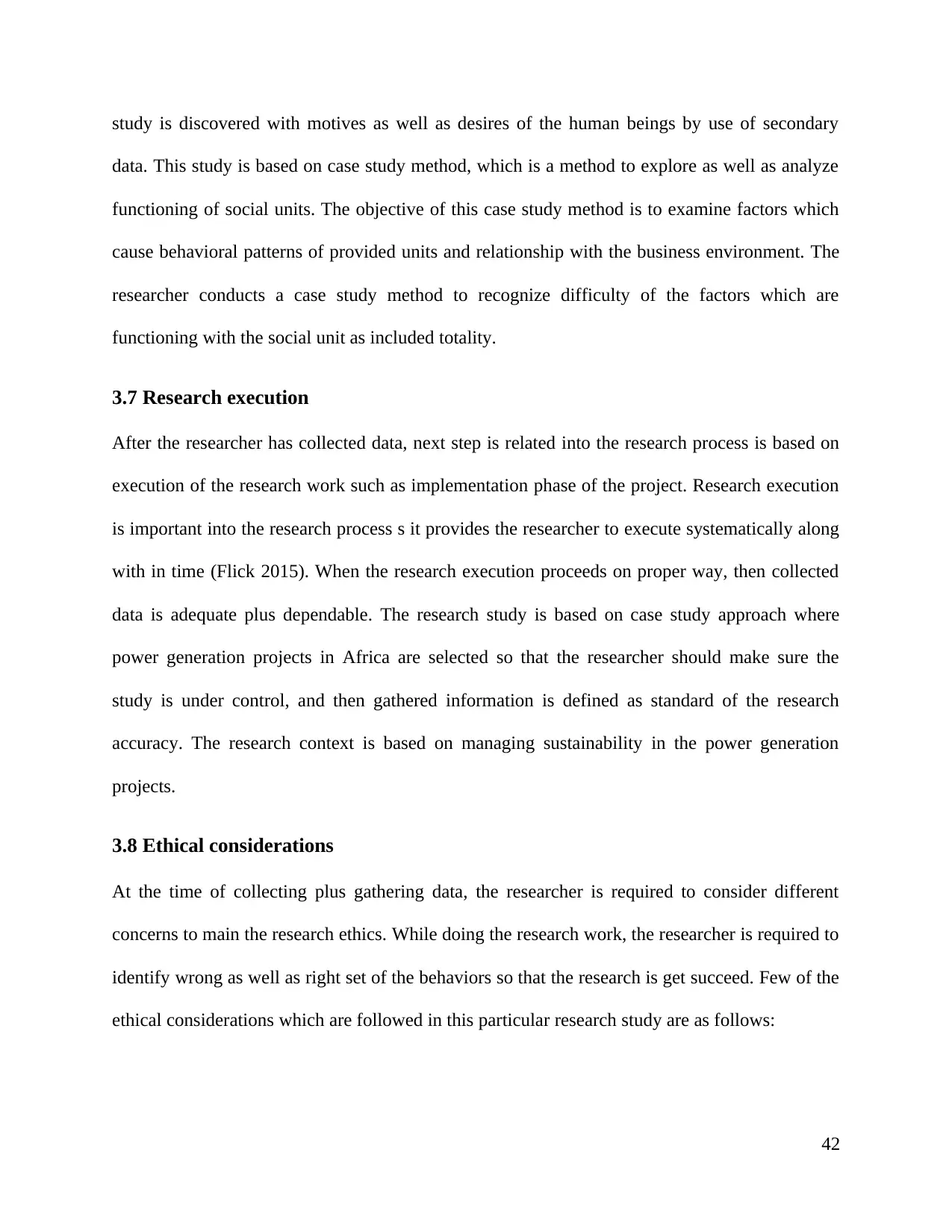
data. This study is based on case study method, which is a method to explore as well as analyze
functioning of social units. The objective of this case study method is to examine factors which
cause behavioral patterns of provided units and relationship with the business environment. The
researcher conducts a case study method to recognize difficulty of the factors which are
functioning with the social unit as included totality.
3.7 Research execution
After the researcher has collected data, next step is related into the research process is based on
execution of the research work such as implementation phase of the project. Research execution
is important into the research process s it provides the researcher to execute systematically along
with in time (Flick 2015). When the research execution proceeds on proper way, then collected
data is adequate plus dependable. The research study is based on case study approach where
power generation projects in Africa are selected so that the researcher should make sure the
study is under control, and then gathered information is defined as standard of the research
accuracy. The research context is based on managing sustainability in the power generation
projects.
3.8 Ethical considerations
At the time of collecting plus gathering data, the researcher is required to consider different
concerns to main the research ethics. While doing the research work, the researcher is required to
identify wrong as well as right set of the behaviors so that the research is get succeed. Few of the
ethical considerations which are followed in this particular research study are as follows:
42
⊘ This is a preview!⊘
Do you want full access?
Subscribe today to unlock all pages.

Trusted by 1+ million students worldwide
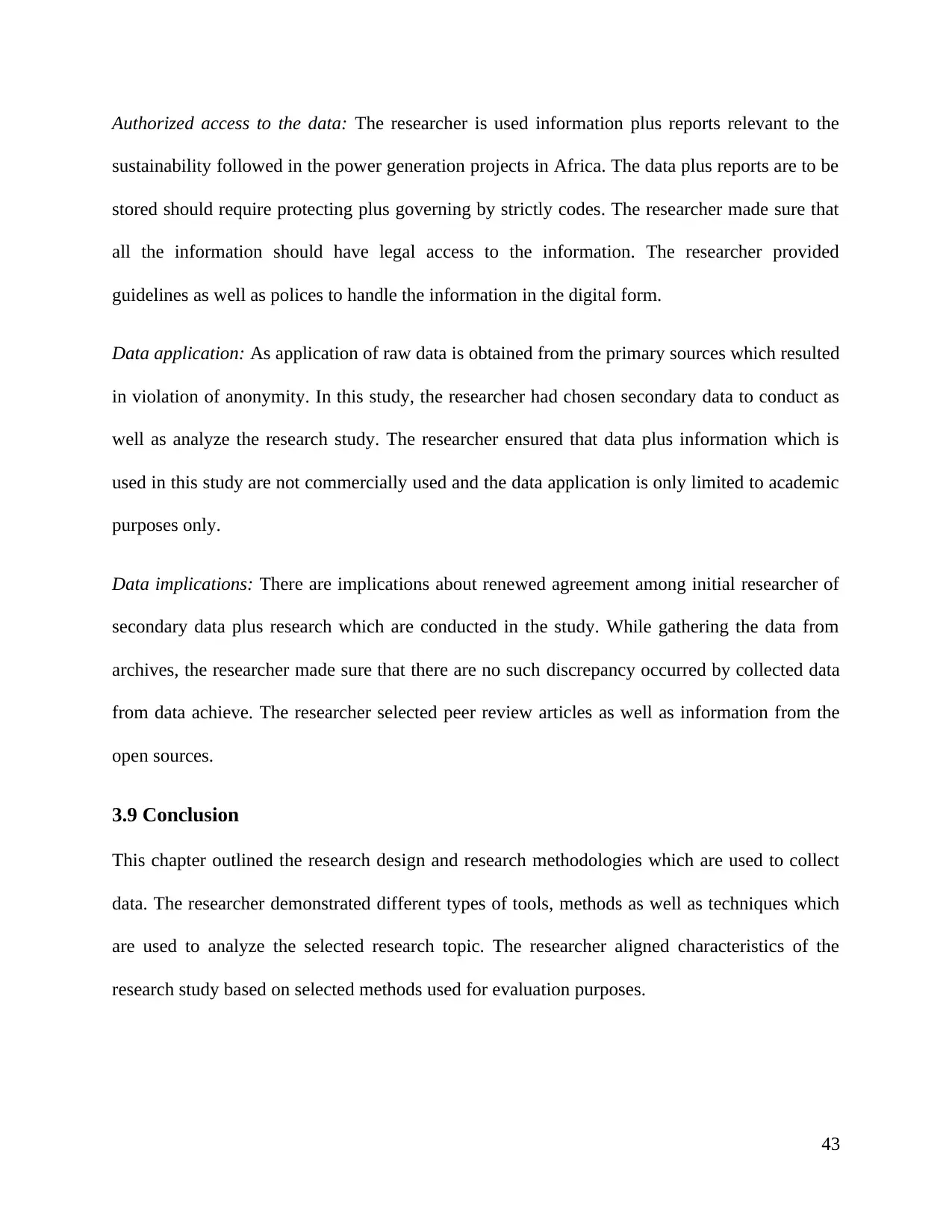
sustainability followed in the power generation projects in Africa. The data plus reports are to be
stored should require protecting plus governing by strictly codes. The researcher made sure that
all the information should have legal access to the information. The researcher provided
guidelines as well as polices to handle the information in the digital form.
Data application: As application of raw data is obtained from the primary sources which resulted
in violation of anonymity. In this study, the researcher had chosen secondary data to conduct as
well as analyze the research study. The researcher ensured that data plus information which is
used in this study are not commercially used and the data application is only limited to academic
purposes only.
Data implications: There are implications about renewed agreement among initial researcher of
secondary data plus research which are conducted in the study. While gathering the data from
archives, the researcher made sure that there are no such discrepancy occurred by collected data
from data achieve. The researcher selected peer review articles as well as information from the
open sources.
3.9 Conclusion
This chapter outlined the research design and research methodologies which are used to collect
data. The researcher demonstrated different types of tools, methods as well as techniques which
are used to analyze the selected research topic. The researcher aligned characteristics of the
research study based on selected methods used for evaluation purposes.
43
Paraphrase This Document
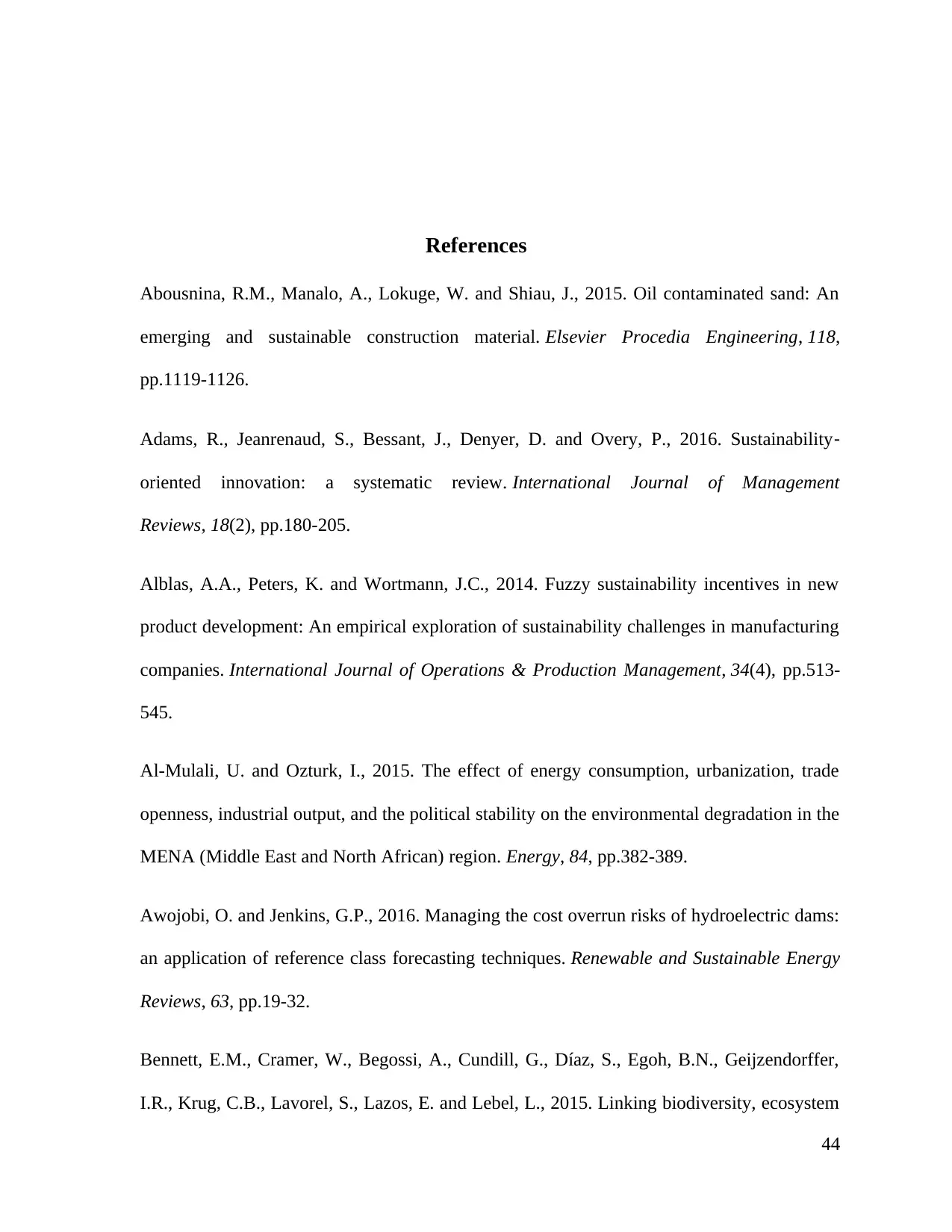
Abousnina, R.M., Manalo, A., Lokuge, W. and Shiau, J., 2015. Oil contaminated sand: An
emerging and sustainable construction material. Elsevier Procedia Engineering, 118,
pp.1119-1126.
Adams, R., Jeanrenaud, S., Bessant, J., Denyer, D. and Overy, P., 2016. Sustainability‐
oriented innovation: a systematic review. International Journal of Management
Reviews, 18(2), pp.180-205.
Alblas, A.A., Peters, K. and Wortmann, J.C., 2014. Fuzzy sustainability incentives in new
product development: An empirical exploration of sustainability challenges in manufacturing
companies. International Journal of Operations & Production Management, 34(4), pp.513-
545.
Al-Mulali, U. and Ozturk, I., 2015. The effect of energy consumption, urbanization, trade
openness, industrial output, and the political stability on the environmental degradation in the
MENA (Middle East and North African) region. Energy, 84, pp.382-389.
Awojobi, O. and Jenkins, G.P., 2016. Managing the cost overrun risks of hydroelectric dams:
an application of reference class forecasting techniques. Renewable and Sustainable Energy
Reviews, 63, pp.19-32.
Bennett, E.M., Cramer, W., Begossi, A., Cundill, G., Díaz, S., Egoh, B.N., Geijzendorffer,
I.R., Krug, C.B., Lavorel, S., Lazos, E. and Lebel, L., 2015. Linking biodiversity, ecosystem
44
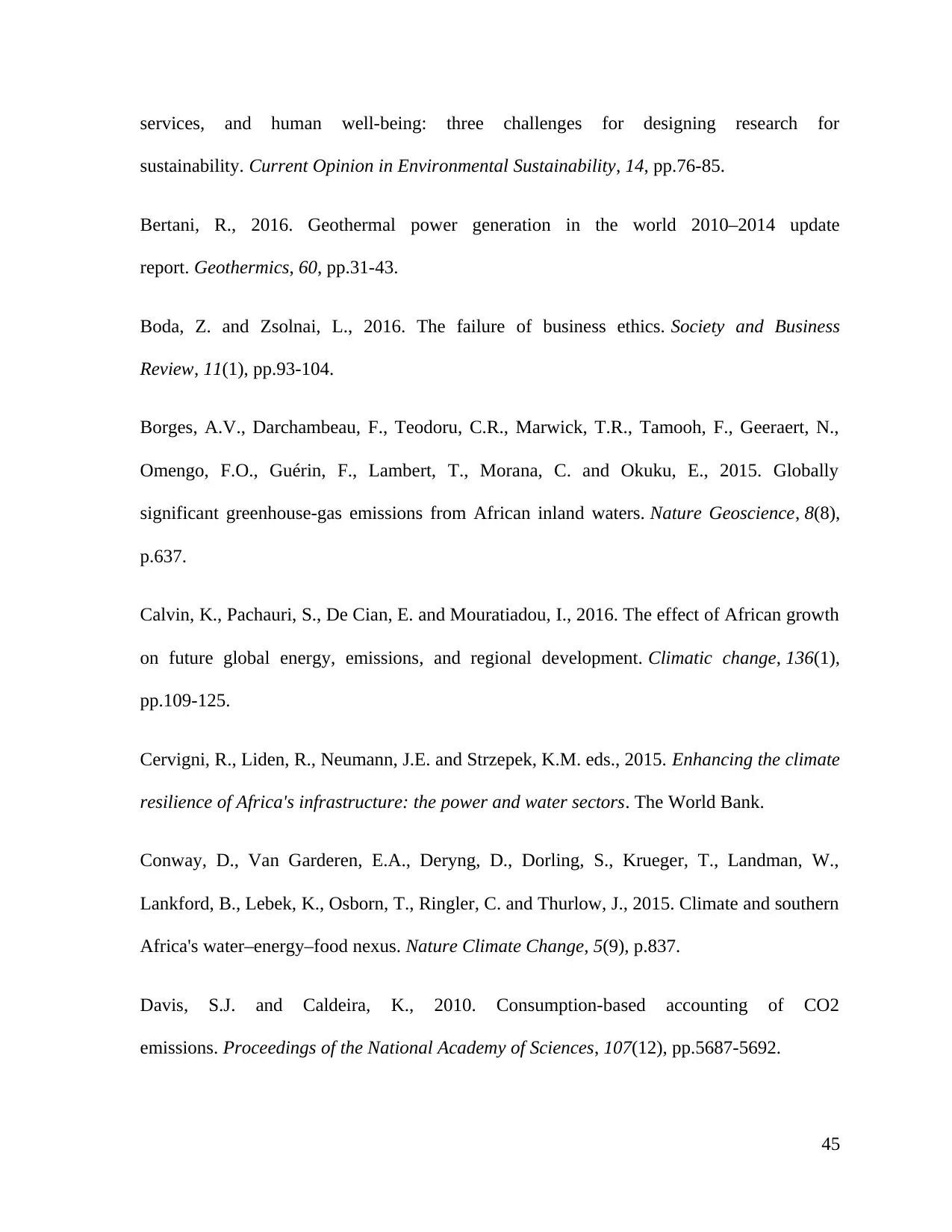
sustainability. Current Opinion in Environmental Sustainability, 14, pp.76-85.
Bertani, R., 2016. Geothermal power generation in the world 2010–2014 update
report. Geothermics, 60, pp.31-43.
Boda, Z. and Zsolnai, L., 2016. The failure of business ethics. Society and Business
Review, 11(1), pp.93-104.
Borges, A.V., Darchambeau, F., Teodoru, C.R., Marwick, T.R., Tamooh, F., Geeraert, N.,
Omengo, F.O., Guérin, F., Lambert, T., Morana, C. and Okuku, E., 2015. Globally
significant greenhouse-gas emissions from African inland waters. Nature Geoscience, 8(8),
p.637.
Calvin, K., Pachauri, S., De Cian, E. and Mouratiadou, I., 2016. The effect of African growth
on future global energy, emissions, and regional development. Climatic change, 136(1),
pp.109-125.
Cervigni, R., Liden, R., Neumann, J.E. and Strzepek, K.M. eds., 2015. Enhancing the climate
resilience of Africa's infrastructure: the power and water sectors. The World Bank.
Conway, D., Van Garderen, E.A., Deryng, D., Dorling, S., Krueger, T., Landman, W.,
Lankford, B., Lebek, K., Osborn, T., Ringler, C. and Thurlow, J., 2015. Climate and southern
Africa's water–energy–food nexus. Nature Climate Change, 5(9), p.837.
Davis, S.J. and Caldeira, K., 2010. Consumption-based accounting of CO2
emissions. Proceedings of the National Academy of Sciences, 107(12), pp.5687-5692.
45
⊘ This is a preview!⊘
Do you want full access?
Subscribe today to unlock all pages.

Trusted by 1+ million students worldwide
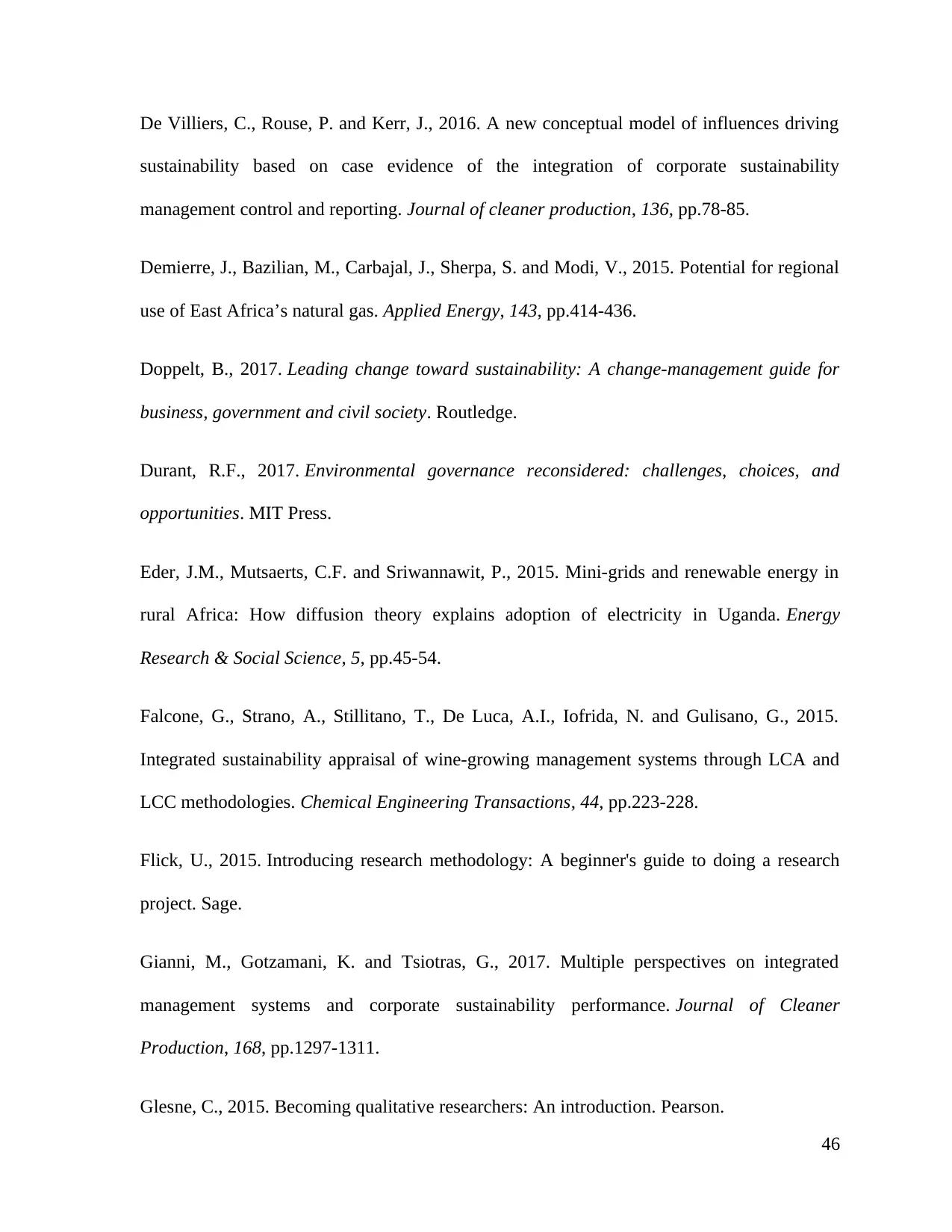
sustainability based on case evidence of the integration of corporate sustainability
management control and reporting. Journal of cleaner production, 136, pp.78-85.
Demierre, J., Bazilian, M., Carbajal, J., Sherpa, S. and Modi, V., 2015. Potential for regional
use of East Africa’s natural gas. Applied Energy, 143, pp.414-436.
Doppelt, B., 2017. Leading change toward sustainability: A change-management guide for
business, government and civil society. Routledge.
Durant, R.F., 2017. Environmental governance reconsidered: challenges, choices, and
opportunities. MIT Press.
Eder, J.M., Mutsaerts, C.F. and Sriwannawit, P., 2015. Mini-grids and renewable energy in
rural Africa: How diffusion theory explains adoption of electricity in Uganda. Energy
Research & Social Science, 5, pp.45-54.
Falcone, G., Strano, A., Stillitano, T., De Luca, A.I., Iofrida, N. and Gulisano, G., 2015.
Integrated sustainability appraisal of wine-growing management systems through LCA and
LCC methodologies. Chemical Engineering Transactions, 44, pp.223-228.
Flick, U., 2015. Introducing research methodology: A beginner's guide to doing a research
project. Sage.
Gianni, M., Gotzamani, K. and Tsiotras, G., 2017. Multiple perspectives on integrated
management systems and corporate sustainability performance. Journal of Cleaner
Production, 168, pp.1297-1311.
Glesne, C., 2015. Becoming qualitative researchers: An introduction. Pearson.
46
Paraphrase This Document
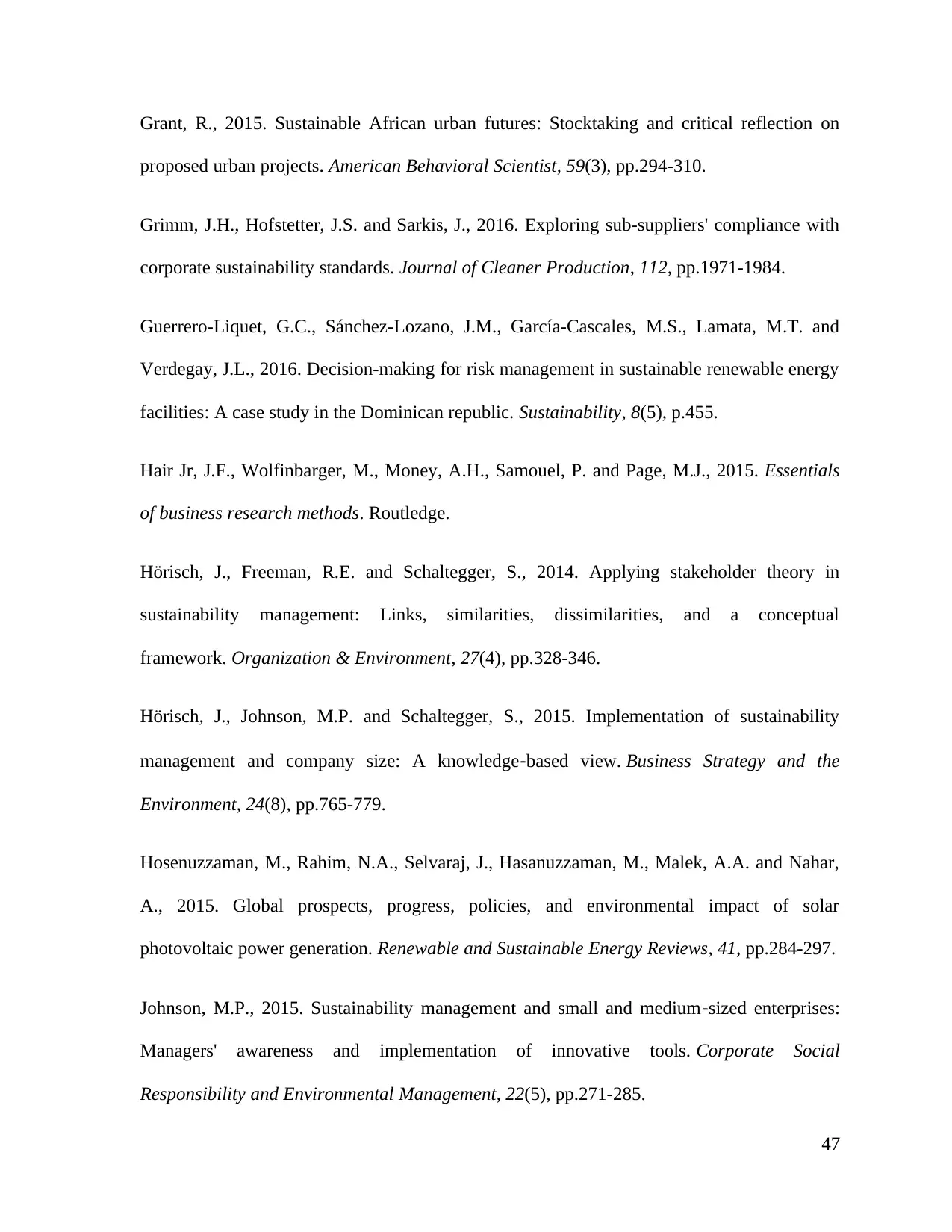
proposed urban projects. American Behavioral Scientist, 59(3), pp.294-310.
Grimm, J.H., Hofstetter, J.S. and Sarkis, J., 2016. Exploring sub-suppliers' compliance with
corporate sustainability standards. Journal of Cleaner Production, 112, pp.1971-1984.
Guerrero-Liquet, G.C., Sánchez-Lozano, J.M., García-Cascales, M.S., Lamata, M.T. and
Verdegay, J.L., 2016. Decision-making for risk management in sustainable renewable energy
facilities: A case study in the Dominican republic. Sustainability, 8(5), p.455.
Hair Jr, J.F., Wolfinbarger, M., Money, A.H., Samouel, P. and Page, M.J., 2015. Essentials
of business research methods. Routledge.
Hörisch, J., Freeman, R.E. and Schaltegger, S., 2014. Applying stakeholder theory in
sustainability management: Links, similarities, dissimilarities, and a conceptual
framework. Organization & Environment, 27(4), pp.328-346.
Hörisch, J., Johnson, M.P. and Schaltegger, S., 2015. Implementation of sustainability
management and company size: A knowledge‐based view. Business Strategy and the
Environment, 24(8), pp.765-779.
Hosenuzzaman, M., Rahim, N.A., Selvaraj, J., Hasanuzzaman, M., Malek, A.A. and Nahar,
A., 2015. Global prospects, progress, policies, and environmental impact of solar
photovoltaic power generation. Renewable and Sustainable Energy Reviews, 41, pp.284-297.
Johnson, M.P., 2015. Sustainability management and small and medium‐sized enterprises:
Managers' awareness and implementation of innovative tools. Corporate Social
Responsibility and Environmental Management, 22(5), pp.271-285.
47

Jones, P., Hillier, D. and Comfort, D., 2016. Sustainability in the hospitality industry: Some
personal reflections on corporate challenges and research agendas. International Journal of
Contemporary Hospitality Management, 28(1), pp.36-67.
Kafel, P., 2016. Benefits of management systems integration. Studia Oeconomica
Posnaniensia, 4(10), pp.122-133.
Karanfil, F. and Li, Y., 2015. Electricity consumption and economic growth: exploring
panel-specific differences. Energy Policy, 82, pp.264-277.
Kibert, C.J., 2016. Sustainable construction: green building design and delivery. John Wiley
& Sons.
Kohler, M., 2014. Differential electricity pricing and energy efficiency in South
Africa. Energy, 64, pp.524-532.
Ledford, J.R. and Gast, D.L., 2018. Single case research methodology: Applications in
special education and behavioral sciences. Routledge.
Lewis, S., 2015. Qualitative inquiry and research design: Choosing among five
approaches. Health promotion practice, 16(4), pp.473-475.
Linger, H. and Owen, J. eds., 2012. The Project as a Social System: Asia-Pacific
Perspectives on Project Management. Clayton, Vic: Monash University Publishing.
Lozano, R., Ceulemans, K. and Seatter, C.S., 2015. Teaching organisational change
management for sustainability: designing and delivering a course at the University of Leeds
48
⊘ This is a preview!⊘
Do you want full access?
Subscribe today to unlock all pages.

Trusted by 1+ million students worldwide

pp.205-215.
Mackey, A. and Gass, S.M., 2015. Second language research: Methodology and design.
Routledge.
Marcelino-Sádaba, S., González-Jaen, L.F. and Pérez-Ezcurdia, A., 2015. Using project
management as a way to sustainability. From a comprehensive review to a framework
definition. Journal of cleaner production, 99, pp.1-16.
Marnewick, C. and Langerman, J., 2018. Agile Maturity: The First Step to Information
Technology Project Success. In Developing Organizational Maturity for Effective Project
Management (pp. 233-252). IGI Global.
Morgan, D., Jonathan, B., Shaky, C. and Vijay, S., 2015. Potential for regional use of East
Africa’s natural gas. Applied energy.
Mutambara, S., Darkoh, M.B. and Atlhopheng, J.R., 2016. A comparative review of water
management sustainability challenges in smallholder irrigation schemes in Africa and
Asia. Agricultural Water Management, 171, pp.63-72.
Nygaard, I. and Dafrallah, T., 2016. Utility led rural electrification in Morocco: combining
grid extension, mini‐grids, and solar home systems. Wiley Interdisciplinary Reviews: Energy
and Environment, 5(2), pp.155-168.
Økland, A., 2015. Gap analysis for incorporating sustainability in project
management. Procedia Computer Science, 64, pp.103-109.
49
Paraphrase This Document
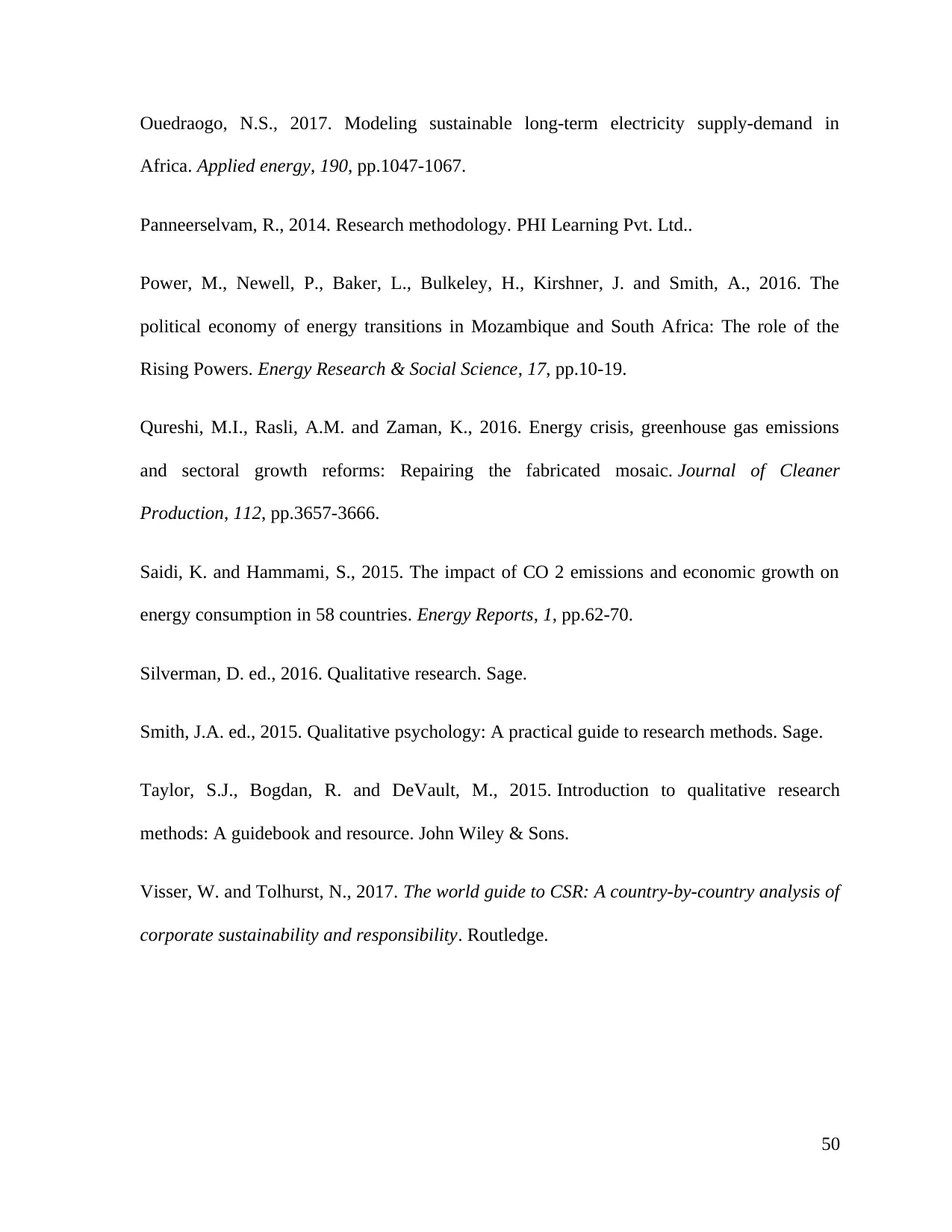
Africa. Applied energy, 190, pp.1047-1067.
Panneerselvam, R., 2014. Research methodology. PHI Learning Pvt. Ltd..
Power, M., Newell, P., Baker, L., Bulkeley, H., Kirshner, J. and Smith, A., 2016. The
political economy of energy transitions in Mozambique and South Africa: The role of the
Rising Powers. Energy Research & Social Science, 17, pp.10-19.
Qureshi, M.I., Rasli, A.M. and Zaman, K., 2016. Energy crisis, greenhouse gas emissions
and sectoral growth reforms: Repairing the fabricated mosaic. Journal of Cleaner
Production, 112, pp.3657-3666.
Saidi, K. and Hammami, S., 2015. The impact of CO 2 emissions and economic growth on
energy consumption in 58 countries. Energy Reports, 1, pp.62-70.
Silverman, D. ed., 2016. Qualitative research. Sage.
Smith, J.A. ed., 2015. Qualitative psychology: A practical guide to research methods. Sage.
Taylor, S.J., Bogdan, R. and DeVault, M., 2015. Introduction to qualitative research
methods: A guidebook and resource. John Wiley & Sons.
Visser, W. and Tolhurst, N., 2017. The world guide to CSR: A country-by-country analysis of
corporate sustainability and responsibility. Routledge.
50
Related Documents
Your All-in-One AI-Powered Toolkit for Academic Success.
+13062052269
info@desklib.com
Available 24*7 on WhatsApp / Email
![[object Object]](/_next/static/media/star-bottom.7253800d.svg)
© 2024 | Zucol Services PVT LTD | All rights reserved.





